Seeing autumn leaves in Korea is an absolute must. Dazzling reds, burning oranges, rich golds, and lush greens paint the cities, forests and mountains of Korea in waves of splendour that shouldn’t be missed. The Korean fall foliage lasts for about 6 weeks and is definitely the best time to travel in Korea. There’s so many reason you’ll love the Korean autumn.
Not only does the Korean countryside come alive with autumn foliage; parks, palaces, fortresses, and other city sights display resplendent views of autumn beauty and provide the perfect backdrop for memorable photos. You don’t have to travel far to see incredible sights during autumn in Korea.
You’ll easily understand why fall is the most popular time to visit Korea and to travel out of the main cities. It’s a season where you can’t stay in, you’ve got to go out and embrace the gorgeous Korean autumn sights. That’s why I want to share this list of the 20 best places to see autumn leaves in Korea.
Affiliate Disclaimer: This site contains affiliate links and I may earn commission for purchases made after clicking these links.
Why You Should See Autumn Leaves In Korea
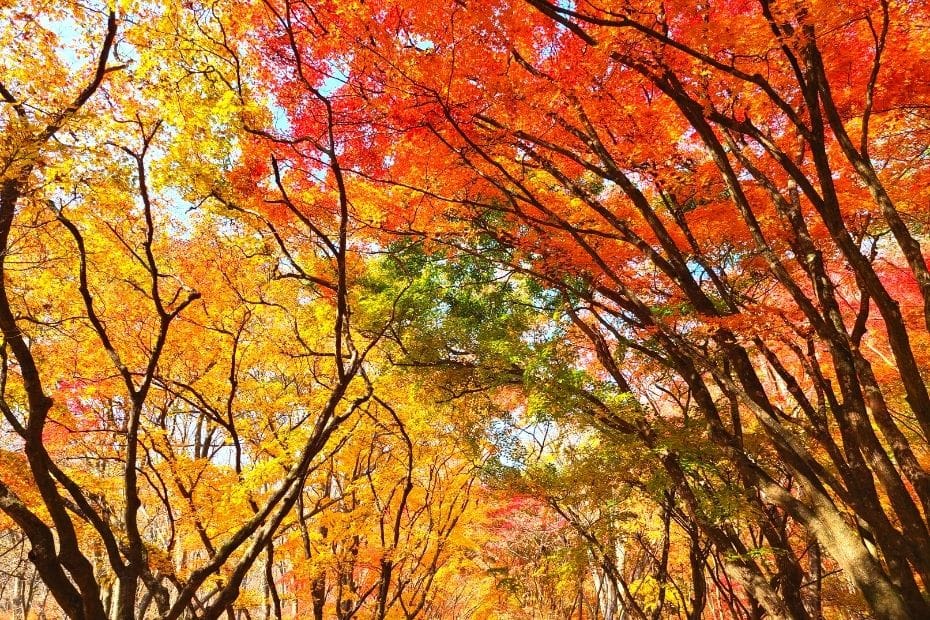
Autumn in Korea is peak travel season for many reasons. The weather is beautiful, with clear skies and warm temperatures. There are several public holidays where people can travel and enjoy this pleasant season. But the biggest attraction in Korea during autumn has to be the beautiful fall foliage.
Korea is a country that’s 70% mountainous and packed with hills, mountains, valleys, and rivers – all of which are blessed with a variety of leafy trees that display breathtaking sights during autumn foliage season. It’s so easy to find a picturesque scene of autumn foliage in Korea wherever you are.
Korean maple trees, golden gingko trees, and giant-leaved platanus trees are some of the stars of this season, producing multi-coloured paintings in the trees above, and crispy, crunchy carpets of leaves on the streets below. There’s also fresh harvest foods, traditional Korean dishes, and fun festivals.
When you mix the beauty of autumn foliage with Korea’s unique architecture and traditional buildings, you realise you don’t have to travel far to see incredible sights. Indeed, some of the best places to see autumn leaves in Korea is in the big cities, especially in the royal palaces and hanok villages.
My Favourite Autumn Foliage Spots
Where should you see autumn foliage in Korea? There are so many places to choose from, all of which I’ll cover in this article, broken down by region. My personal top 5 places to see autumn foliage in Korea (which I’ve visited many times since moving to Korea in 2015) are as follows:
- Naejangsan National Park
- Nami Island
- The Secret Garden
- Seoraksan National Park
- Bulguksa Temple
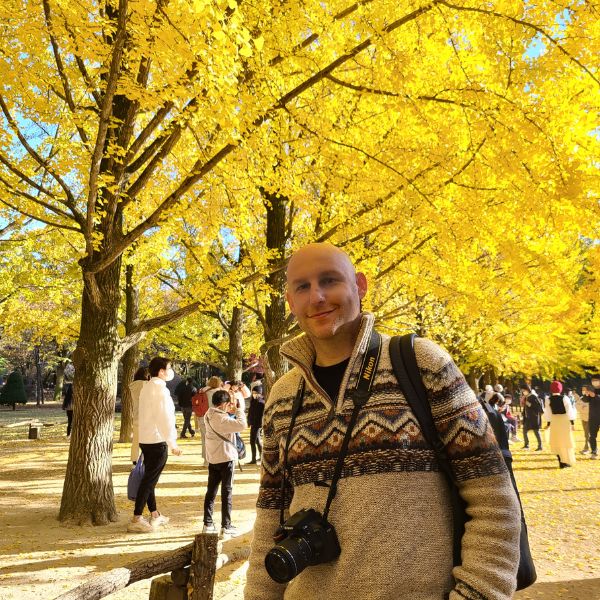
These sights are just the tip of the foliage iceberg. There are many more wondrous sights awaiting you in Korea this autumn. Keep reading to find out what awaits you.
What Are You Looking For?
To help make it easier for you to find what you’re looking for, I’ve broken this article into the following sections. Click the quick links below to jump straight there or keep reading through all parts.
Planning to visit Korea? These travel essentials will help you plan your trip, get the best deals, and save you time and money before and during your Korean adventure.
Visas & K-ETA: Some travellers to Korea need a Tourist Visa, but most can travel with a Korean Electronic Travel Authorisation (K-ETA). Currently 22 Countries don’t need either one.
How To Stay Connected: Pre-order a Korean Sim Card or a WiFi Router to collect on-arrival at Incheon Airport (desks open 24-hours). Alternatively, download a Korean eSIM for you travels.
Where To Stay: For Seoul, I recommend Myeongdong (convenient), Hongdae (cool culture) or Gangnam (shopping). For Busan, Haeundae (Beach) or Seomyeon (Downtown).
Incheon Airport To Seoul: Take the Airport Express (AREX) to Seoul Station or a Limo Bus across Seoul. Book an Incheon Airport Private Transfer and relax to or from the airport.
Korean Tour Operators: Tour companies that have a big presence in Korea include Klook, Trazy, Viator, and Get Your Guide. These sites offer discounted entry tickets for top attractions.
Seoul City Passes: Visit Seoul’s top attractions for free with a Discover Seoul Pass or Go City Seoul Pass. These passes are great for families and couples visiting Seoul – you can save lots.
How To Get Around: For public transport, grab a T-Money Card. Save money on Korea’s high speed trains with a Korea Rail Pass. To see more of Korea, there are many Rental Car Options.
Travel Money: Use money exchanges near Myeongdong and Hongdae subway stations for the best exchange rates. Order a Wise Card or WOWPASS to pay by card across Korea.
Flights To Korea: I use flight comparison sites such as Expedia and Skyscanner to find the best flights to Korea from any country. Air Asia is a good option for budget flights from Asia.
How To Learn Korean: The language course from 90 Day Korean or Korean Class 101 both have well-structured lessons and lots of useful resources to help you learn Korean.
Official Korean Autumn Leaves Forecast 2024
Please note: The 2024 autumn foliage forecast for Korea will be available from early September 2024. This 2023 forecast will give you a rough idea of when to visit various places.
When is the best time to visit Korea for autumn leaves in 2024? When does autumn foliage appear in Korea in 2024? Knowing when the fall foliage in Korea starts and peaks is the key to timing your journey around the country, catching the autumn foliage at the perfect time.
Korean autumn foliage begins at the start of October in northern parts of Korea, peaks by mid to late October, and ends in southern Korea in early November with the arrival of colder winter weather and snow. The start, peak, and end dates change depending on which part of Korea you’re in.
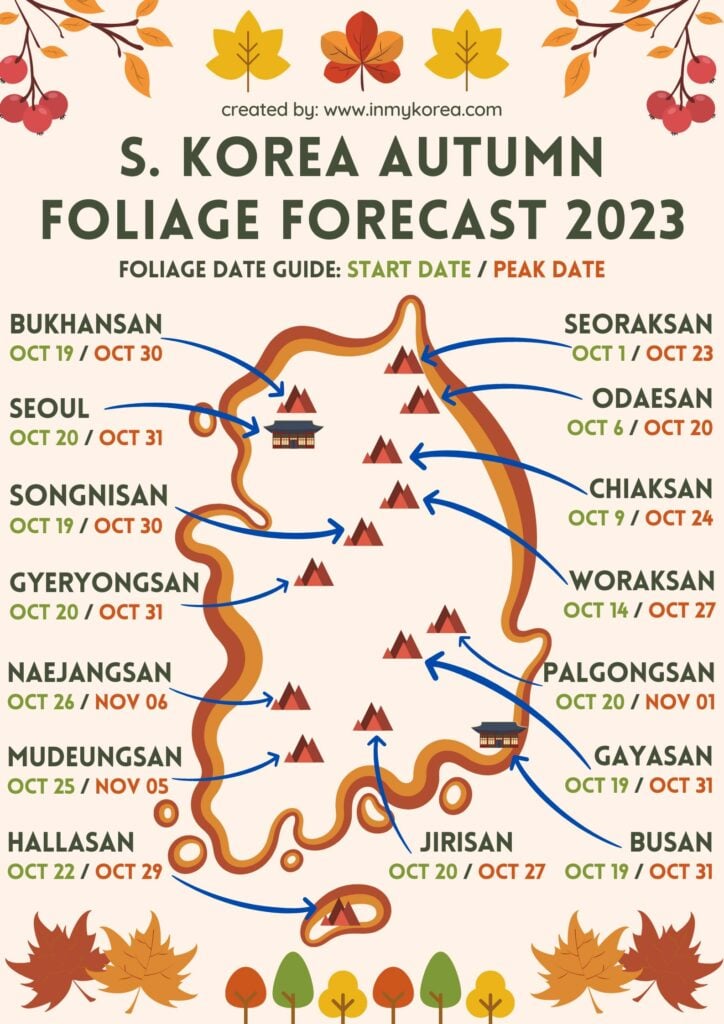
The Korean autumn foliage dates were later than usual in 2023 due to higher average daily temperatures in September and October that were higher or slightly higher than usual. As a result, the first foliage date moved from September to October in 2023 and peak dates are slightly later, too.
The first place for autumn foliage in Korea is on the north-east coast, with Seoraksan National Park being one of the first and also most impressive places to see Korean autumn leaves. The autumn foliage in Seoraksan began at the start of October in 2023, but peaked 3 weeks later on October 23rd.
Seoul’s autumn foliage began on October 20th in 2023 and peaked by October 31st. There were still fall leaves on the ground in early November, but October is definitely the best time to visit Seoul for fall foliage. Bukhansan National Park and Nami Island saw autumn foliage at the same time.
In central Korea, including Daejeon, Songnisan National Park, and Woraksan National Park, the autumn foliage began and peaked from mid-October until late October, lasting until early-mid November. Fall foliage on the east coast of Korea started early October and peaked late October.
In Busan and southern Korea, including Jirisan National Park, the fall foliage began in mid-October and peaked by the end of October. Jeju Island autumn foliage also began in mid-October and peaked by the end of October. Late October is the best time to view autumn leaves in Busan and Jeju.
The last place to see autumn foliage in Korea is around Naejangsan National Park, where the autumn leaves appear at the end of October and peak in the first week of November. Naejangsan is one of the last places to see autumn foliage in Korea, but also one of the most beautiful places.
If you want to know more about travelling in Korea’s different seasons, check out seasonal articles. Also visit my guide to visiting Korea in October, which is arguably the best month to travel in Korea, for info about where to go, what to see, festivals, foods, and lots more.
Korean Autumn Foliage Forecast FAQs
The peak dates for the Korean fall foliage forecast don’t mean the end dates of the leaves, but the time when they are on display and most beautiful. The autumn foliage can remain for another week or more, depending on the weather and tree types.
Autumn foliage can last for a long time – lying as golden blankets of gingko leaves or red rivers of maple leaves. You can still see autumn leaves in early November in some places, especially in the southern parts of Korea. Follow them from north to south to get the most of this season.
Here’s a table showing the Korean autumn foliage dates by national park:
| National Park | Start Date | Peak Date |
|---|---|---|
| Seoraksan | Oct 1st | Oct 23rd |
| Odaesan | Oct 6th | Oct 20th |
| Chiaksan | Oct 9th | Oct 24th |
| Woraksan | Oct 14th | Oct 27th |
| Bukhansan | Oct 19th | Oct 30th |
| Gayasan | Oct 19th | Oct 31st |
| Palgongsan | Oct 20th | Nov 1st |
| Jirisan | Oct 20th | Oct 27th |
| Hallsan | Oct 22nd | Oct 29th |
| Gyeryongsan | Oct 20th | Oct 31st |
| Songnisan | Oct 19th | Oct 30th |
| Mudeungsan | Oct 25th | Nov 5th |
| Naejangsan | Oct 26th | Nov 6th |
According to the Korean weather service, this autumn is due to be hotter than average with rainfall also slightly above average. Here is the predicted weather outlook for autumn dates in September and October in 2023.
| Period | Expected Temperatures |
|---|---|
| Sept 18 – Sept 24 | Temperatures will be higher than average. |
| Sept 25 – Oct 01 | Temperatures will be similar to or higher than. |
| Oct 02 – Oct 08 | Temperatures will be similar to or higher than average. |
| Oct 09 – Oct 15 | Temperatures will be higher than average. |
| Oct 16 – Oct 22 | Temperatures will be similar to or higher than average |
Source: Korea Meteorological Administration Seasonal Weather Information Manual
The official Korean autumn leaves forecast for 2024 is available from early September, and is based on the most up to date forecast information from the Korean forecasting service. The 2023 autumn foliage can be used to work out the 2024 Korean autumn foliage forecast dates.
In 2023, the Korean autumn foliage started to peak on October 20th at Odaesan National Park and finished peaking in Naejangsan National Park on November 6th, 2022. The autumn foliage in Seoul started on October 20th and peaked October 31st.
Recommended Korean Autumn Foliage Tours
This article introduces the best autumn foliage spots in Korea, starting with Seoul and covering the whole country, including Jeju Island. If you’re interested in booking an autumn foliage tour, here are some of the best tours available this autumn. Please note that tours book out quickly in this season.
Here are some of the best tours you can take in Korea this autumn:
Not sure if you need an autumn foliage tour in Korea or not? They can certainly save time and effort and help you avoid long journeys on public transportation. In this guide to the best Korean autumn foliage spots, I’ll include details about how to get to each place so you can see if it’s feasible or not.
Where To See Autumn Leaves In Seoul 2024
Seoul is one of the best places to visit during any trip to Korea and there are so many incredible things to do in Seoul all year round. Visiting Seoul in autumn is even better as you can see these sights with the added charm and magnificence of autumn foliage towering above or carpeting the streets below.
Here are 10 amazing places to see autumn leaves in Seoul:
1: Seoul’s Royal Palaces & Secret Garden
Marvel at the contrast between nature and history in Seoul’s Royal Palaces during autumn and see aesthetic delights provided by traditional Korean architecture blended with the natural beauty of autumn in Korea.
All of the palaces in Seoul will offer incredible views of autumn leaves, but the best place to visit has to be the Secret Garden located inside Changdeokgung Palace. This hidden garden showcases some of the finest fall foliage in Korea.

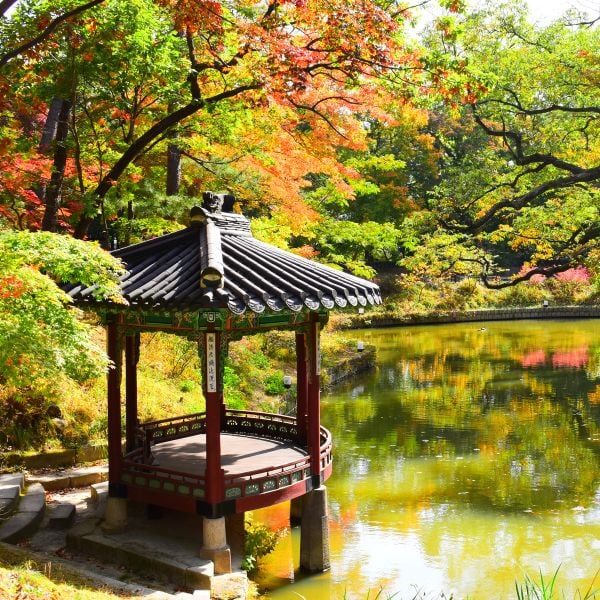
There’s a beautiful pond where you can see the golden autumn leaves reflected in the water. Entry to the garden is limited each day, therefore get there early to book tickets and avoid disappointment.
Don’t forget to hire traditional Korean hanbok for truly memorable pictures. Not only will you look great, you’ll get free entry to the royal palaces if you’re wearing it!
Here are the closest subway stations to each of Seoul’s 5 royal palaces:
Gyeongbokgung Palace: Gyeongbokgung Station (Line 3 – Orange)
Changdeokgung Palace: Anguk Station (Line 3 – Orange)
Changgyeonggung Palace: Anguk Station (Line 3 – Orange)
Deoksugung Palace: City Hall Station (Line 1 – Dark Blue)
Gyeonghuigung Palace: Gwanghwamun Station (Line 5 – Purple)
The Secret Garden is inside Changedeokgung Palace. You will need to reserve tour tickets on the day you want to visit. I recommend getting there as early as possible as the tickets go quickly.
2: N Seoul Tower
The N Seoul Tower in the heart of Seoul is a great place to hike and see fall foliage on cool autumn days, as well as impressive views of Korea’s capital from up high.
You can hike from Myeongdong Station all to the top, passing old stone walls, leafy trees, and views of Seoul to the sides. For an easier journey, take the Namsan Cable Car. Relax on the short journey to the peak and back, taking in the sights as you go.
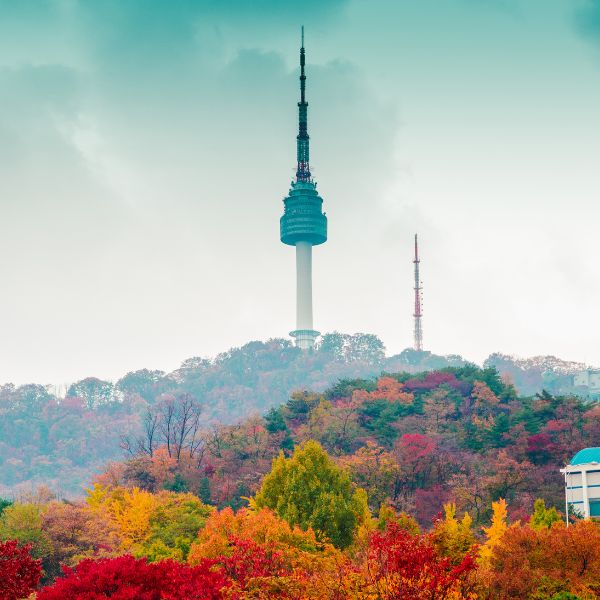
Cable Car: Head out of Exit 3 from Myeongdong Station and walk towards the cable car station up the hill. Return tickets cost 14,000 KRW for adults and 10,500 KRW for children. The cable car runs from 10:00 am to 11:00 pm every day.
Shuttle Bus: These are hop-on hop-off buses that also cover many of central Seoul’s top sights. Bus numbers 2 & 4 go to the N Seoul Tower. Here’s a guide to Getting To N Seoul Tower.
Discounted Tickets: If you want to save money on entrance, you can buy discounted entry tickets from Klook and save over 20% on the entrance fee.
Discover Seoul Pass: Want to see the N Seoul Tower and many other premium attractions in Seoul for free? Then why not purchase a Discover Seoul Pass and save a lot of money. Find out more in my article about Discover Seoul Pass itineraries.
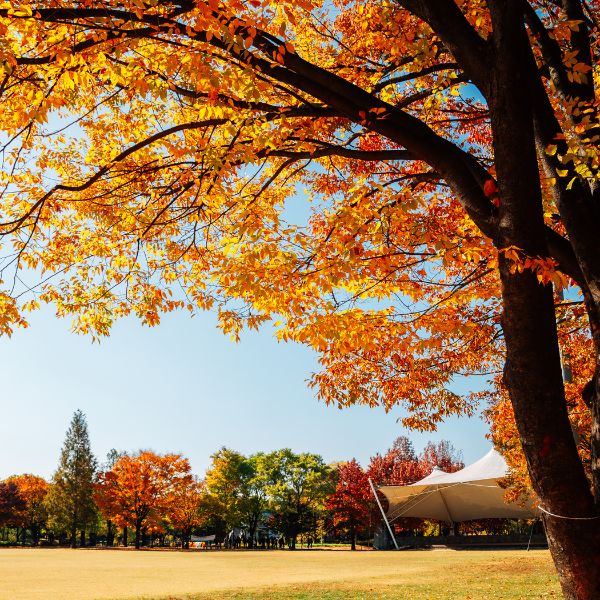
3: Seoul Forest Park
With platanus trees dropping leaves the size of dinner plates, you’ll find some unique autumn foliage in Seoul Forest Park. This is a great place for families to spent time outside in Seoul. In the park you’ll find a petting zoo, deer, playgrounds, flower displays, and lots more.
If you’re in the area, be sure to check out the trendy cafe and restaurant area north of Seoul Forest. You’ll find lots of delicious modern Korean cuisine here.
Take the subway to Seoul Forest Station (Bundang Line – Orange). You’ll see signs for the park as you exit. The cafe and restaurant area is above the northern entrance to Seoul Forest, closer to Ttukseom subway station.
4: Kyung Hee University
Kyung Hee University is my favourite campus to see autumn foliage in Seoul and features picturesque views of forested hills overlooking European style buildings. Walk along gingko tree-lined streets before discovering maple trees hanging low over stone bridges and forest paths.
It takes 2 hours to explore the campus, seeing the beautiful scenery. After enjoying a tour around Kyung Hee University, visit the nearby student cafes and restaurants for cheap eats and relaxing views.
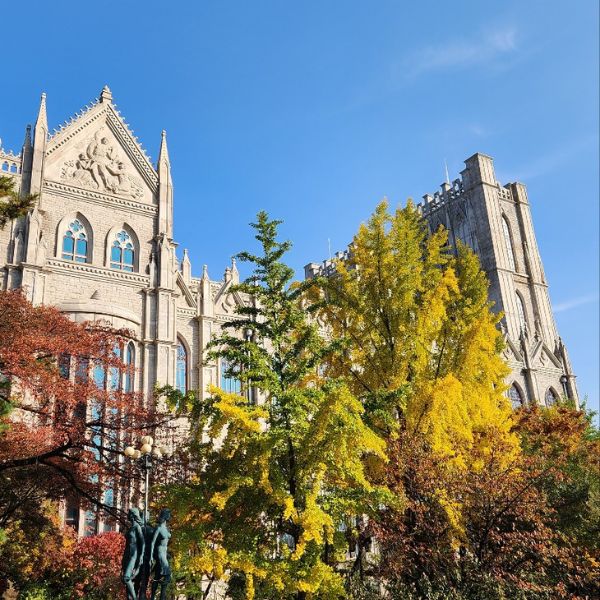
Take the subway to Hoegi Station and use exit 1. The campus is under the hills in front of you. Walk for about 10 minutes to get to the entrance of the university.

5: Gwanaksan Mountain
Located in the heart of the downtown Seoul area, close to Seoul National University, is Gwanaksan Mountain. This popular hiking area provides peaceful tree-lined streets and leaves you with a view overlooking the modern Gangnam area.
It’s a great site and, above all, it’ll give you a chance to hike without leaving the city. Take some time out to visit Yeonjuam Hermitage, a temple located on the side of the mountain.
Take the subway to Gwacheon Station (Line 4 – Light Blue) and go out Exit 7. You’ll need to walk around the buildings towards the hiking trail entrance.
6: Seoul Grand Park
Located in the same area as Gwanaksan Mountain, the Seoul Grand Park is a place for families to have fun in nature and to enjoy autumn foliage sights in Seoul away from tall buildings and concrete.
This sprawling park, surrounded by wooded slopes, includes Seoul Land, Seoul Zoo, a petting zoo, gardens, and a central lake that’s ringed by a long tree-lined walkway with small parks and benches to rest in while taking in the autumn leaves above.
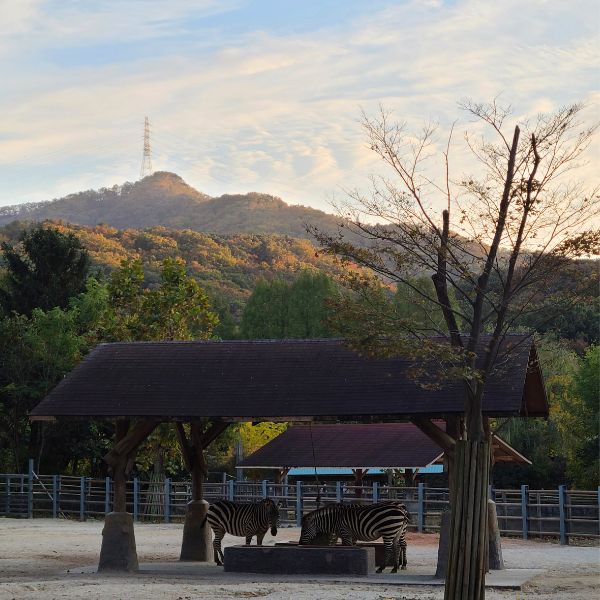
Take the subway to Seoul Grand Park Station (Line 4 – Light Blue). You’ll see signs for the park as you exit. You don’t need a ticket to enter the park area, but there will be tickets available for Seoul Land and Seoul Zoo, which are inside the park.
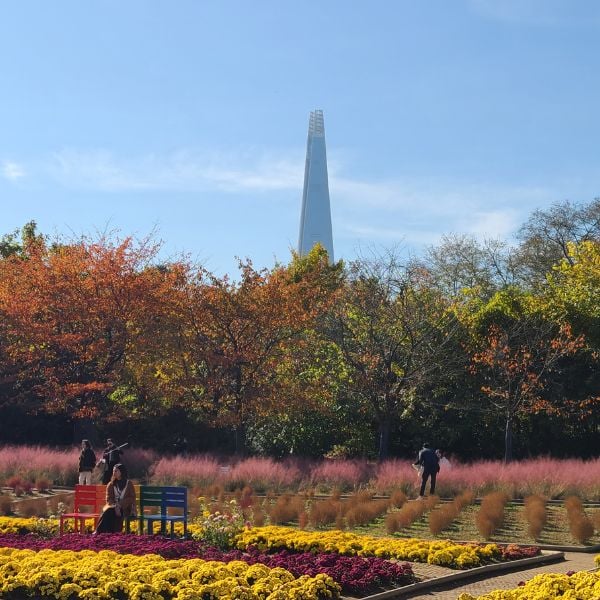
7: Seoul Olympic Park
Seoul’s Olympic Park is a large open park in the Songpa district of Seoul that’s more peaceful than some of Seoul’s other parks. It’s a place for people to stroll slowly through the maze-like pathways, taking in the natural sights along the way.
What makes Olympic Park such a nice place to visit in autumn is the combination of floral displays, patches of pink muhly, and the rows of trees with autumn leaves, as well as the impressive view of the Lotte World Tower in the background.
Take the subway to Olympic Park Station (Line 5 – Purple or Line 9 – Gold) and use exits 3 or 4. There are several entrances and exits to the park, but there are convenience stores, toilets, and some cafes near this entrance, so it’s more convenient.
8: Seokchon Lake
Seokchon Lake rests below the imposing Lotte World Tower in Jamsil and is the perfect place for an autumn foliage viewing break in Seoul after shopping in the tower or visiting Lotte World Adventure.
Sit in one of the lakeside cafes and watch the rusty leaves fall or take a walk around the figure-of-eight shaped lake. There are many fall foliage sights at Seokchon Lake, so keep walking to find new sights with the Lotte World Tower as a unique background.
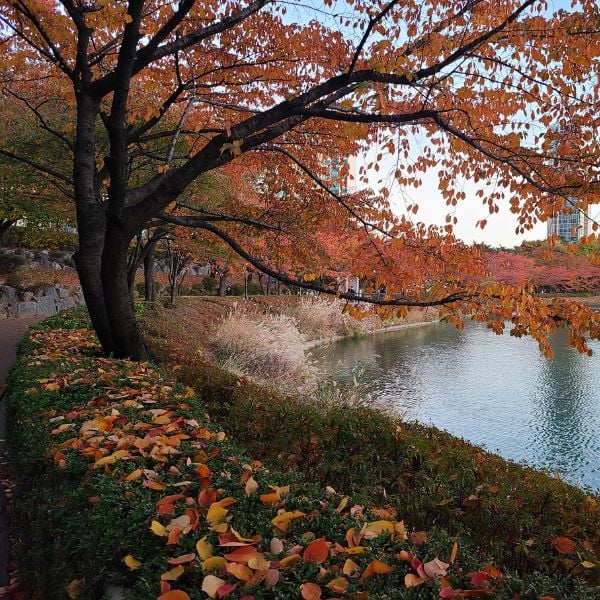
Take the subway to Jamsil Subway Station (Lines 2 & 8) and go out exit 2 or 3. Seokchon lake is visible in front of you. Walking around the park takes about an hour or more.
If you plan to visit some of the other attractions in the area, such as Lotte World Adventure or the Lotte World Tower Observatory, I recommend booking tickets online, it’s cheaper.
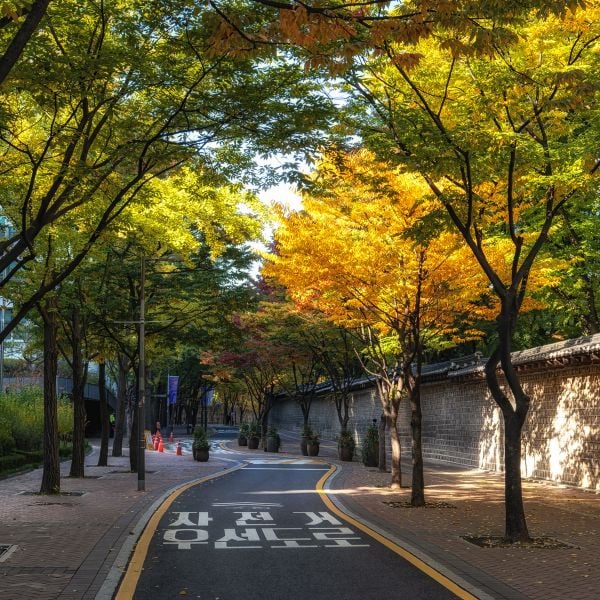
9: Deoksugung Palace Stone-Wall Road
Not only can you see autumn leaves inside Seoul’s royal palaces, there’s a chance to see them creeping over the stone walls from the outside, too. The best place to see this in Seoul is the Deoksugung Stone-Wall Road outside of Deoksugung Palace.
This street curves around the palace for 900 metres, lined by tall palace walls with Korean-style curved tiles on top. There are many leafy trees both on the road and inside the palace that create a stunning view as you walk along the peaceful roads.
Take the subway to City Hall station (Line 1 – Dark Blue). Use exit 1, 2, or 3 and Deoksugung Palace will be right in front of you. Walk around the outside of the palace for the stone-wall road.
Address in Korean: 서울 중구 정동
10: Haneul Sky Park
Haneul Sky Park is one of the prettiest of the Han River riverside parks and really comes to life in autumn thanks to the ocean of tall silver reeds (Eulalia) that crowns this wide hilltop park.
Not only can you see silver reeds at Haneul Sky Park, there are also long, stretching views across the Han River and the riverside parks, with some of my favourite autumn foliage views in the whole of Seoul. If you’re looking for pink muhly in Seoul, the Haneul Sky Park has a big garden full of it.
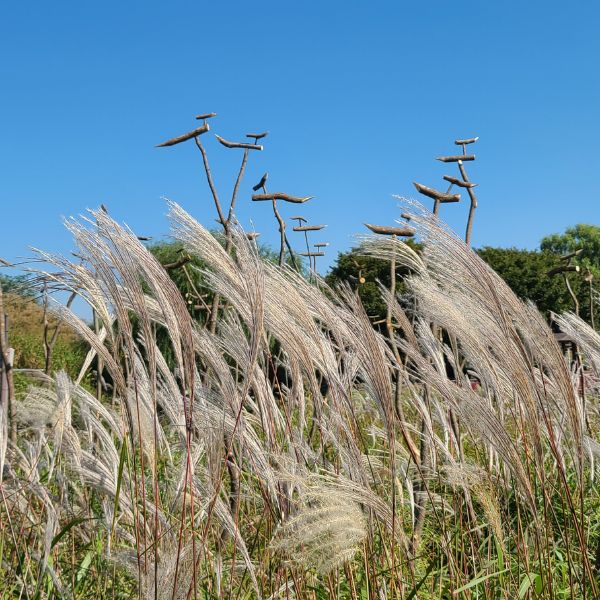
Take a subway to World Cup Stadium (Line 6 – Brown) and head towards the rivers. There are many parks in this area. Haneul Sky Park is on top of the hill – you can’t miss it. You can also find the Oil Tank Culture Park here, a free attraction in Seoul that is worth a visit.
Autumn Foliage Day Trip Locations Near Seoul
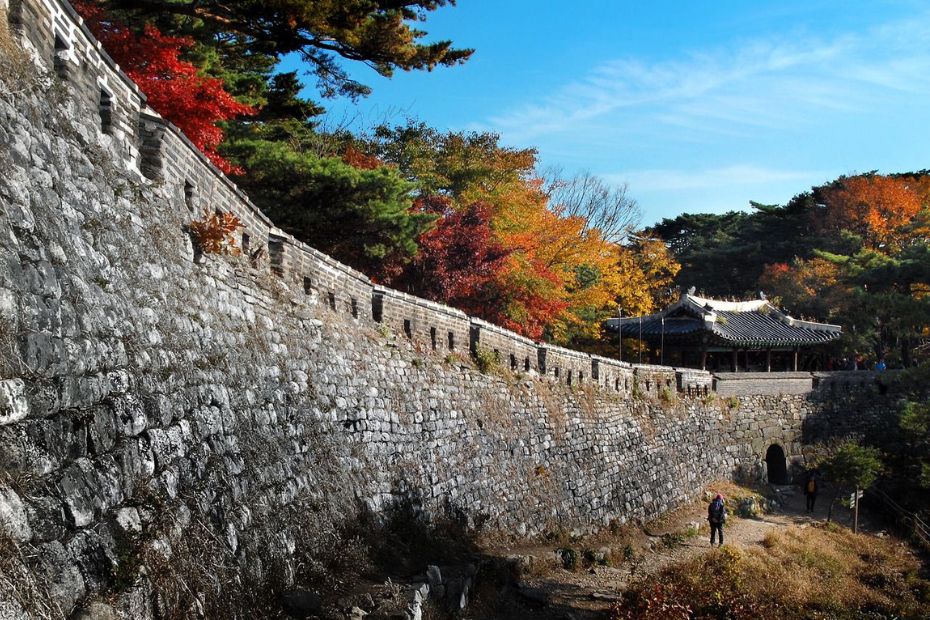
There are many beautiful autumn foliage spots in Seoul. However, some of the most spectacular spots are outside the city, located in the Korean countryside that surrounds the capital. These autumn foliage spots can all be reached from Seoul within an hour or two by car, tour, or public transport.
Here are 7 amazing autumn foliage day trips locations near Seoul:
1: Nami Island
Nami Island is famed for its year round natural beauty, but the best time to visit is definitely in autumn. With tree-lined streets of giant metasequoia and golden gingko, this is one of the most pleasant places to see autumn leaves in Korea.
Known as a family-friendly eco-park, as well as a romantic day-trip spot, there’s something for everyone here. You can combine a day trip to Nami Island with the Garden of Morning Calm for a perfect day of fall foliage viewing.

There are many ways to get to Nami Island from Seoul, including a free shuttle bus, train (from Cheongpyeong Station), bus (from Cheongpyeong Terminal), or a guided tour.
For details about how to get to Nami Island, as well as more pictures of Nami Island in autumn, check out my guide about getting to Nami Island from Seoul.
Address in Korean: 경기 가평군 가평읍 달전리 145-2
Tour Options: The best way to see Nami Island’s autumn foliage is with a guided tour that will also take you to some of the other hot sights in the area, including Seoraksan, Garden of Morning Calm, and the Ganhchon Rail Bike. Here are some of the tours available for Nami Island:
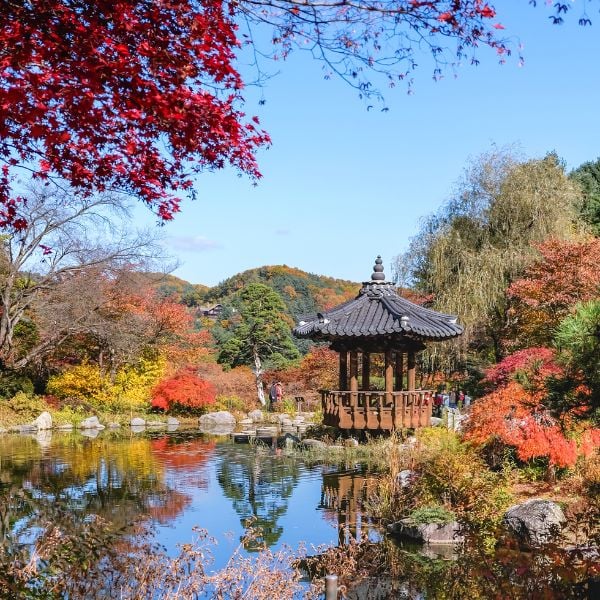
2: Garden Of Morning Calm
Close to Nami Island, this sculptured garden provides dozens of pathways through hundreds of beautiful plants, trees, and bushes. The Garden of Morning Calm also holds festivals throughout the year, including the gorgeous Maple Tree Festival.
Strolling through this area provides dozens of opportunities to get close to nature, and take some amazing pictures, too. Coupled with Nami Island, this makes for a great day trip out of Seoul and a chance to really see a beautiful, natural side to Korea.
There are many ways to get to the Garden of Morning Calm from Seoul, including by train or subway (Cheongpyeong Station), by bus (Cheongpyeong Terminal), the Gapyeong City Tour Bus, or with a guided tour. Here’s a guide about getting to The Garden of Morning Calm.
Tour Options: Tours to the Garden of Morning Calm from Seoul typically include a trip to Nami Island or nearby attractions, such as Alpaca World, Petite France & the Gangchon Railbike.
3: Asan Gingko Tree Road
Imagine yourself strolling down the beautiful, tree-lined streets of Asan Gingko Tree Road, with a carpet of golden leaves below, and lemony clouds above. Gingko trees are famous for their copious leaves and creating a golden carpet all around. In short, it really is magical and worth the trip.
There are two trees that are perfect for seeing autumn leaves in Korea, they are the maple and gingko. The Asan Gingko Tree Road specialises in the latter and is the best place to see this gorgeous golden cascade of colours.

To get to Asan Gingko Tree Road, take the KTX from Seoul Station (40 minutes) to Asan Station, then change to the subway (Line 1 – Dark Blue) and travel 4 stops until you get to Onyang Spa Station (온양온천역). From Onyang Spa Station, take a taxi to Asan Gingko Tree Road (은행나무길).
Address in Korean: 충남 아산시 염치읍 석정리
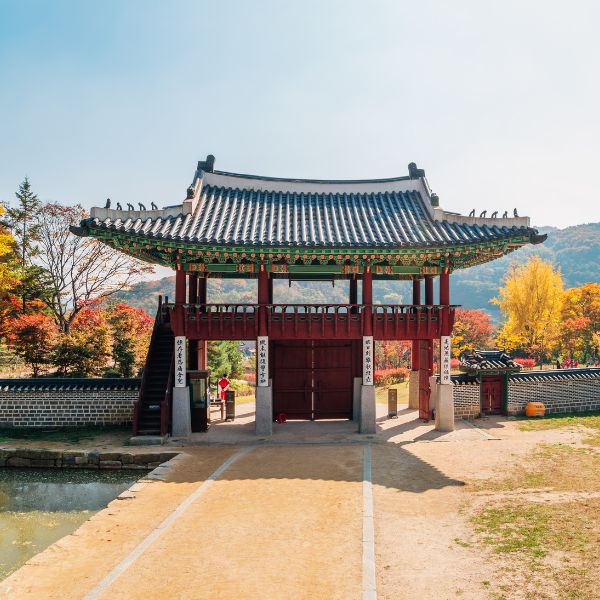
4: Namhansanseong Provincial Park & Fortress
A lesser-known autumn leaves hotspot in Korea is the Namhansanseong Provincial Park and Fortress. Located a short distance from Seoul, this is a great place to see fall foliage away from the city and the crowds.
There are several hiking paths to enjoy, as well as cultural relics from Korea’s past. Hiking paths take as little as 90 minutes but pass through several historic and natural sights. Top sights include the tall fortress gates, Sueojangdae, the pine forest, and 12.4km of fortress walls.
From Samseong Station (Line 8 – Red), take bus 52, 9, or 9-1 directly to the fortress.
From Seoul Station, take bus 9000 (red bus) and transfer to bus 9 at the Jongham Bus Terminal (종합버스터미널).
I recommend using Naver Map from your start point in Seoul and using the Korean address (below) to search for more accurate directions on the day of travel.
Address in Korean: 경기 광주시 남한산성면 산성리 935-1
5: Hwadam Botanic Garden
Hwadam Botanic Garden is a large, beautiful eco-friendly arboretum inside the Konjiam Resort, which is a popular ski and spa resort close to Seoul. Featuring over 4,300 types of trees and plants spread over 165,000 square metres, this is an impressive place to come and enjoy autumn foliage in Korea.
One of the highlights of this botanic garden has to be the monorail path which takes you through the crispy canopies, offering the most incredible sights of the autumn foliage at eye level. If you visit Hwadam Botanic Garden, you really must take a ride on the monorail.
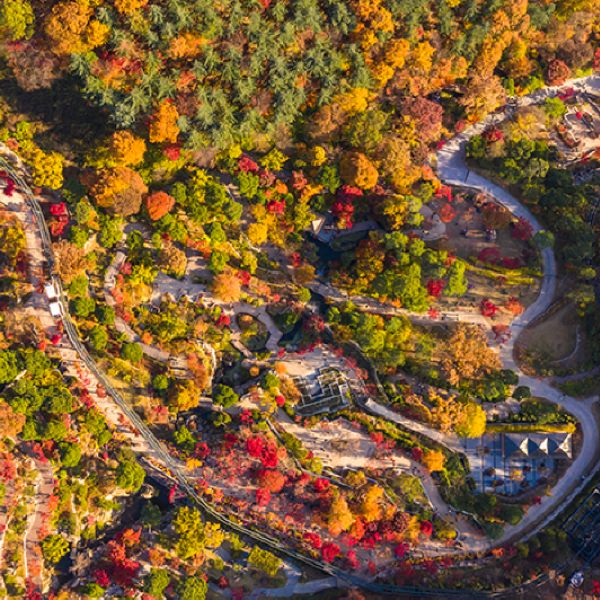
By Bus: To get to Hwadam Botanic Garden from Seoul, you will need to take a bus from Seoul to Konjiam Terminal. From the Konjiam Terminal, change to local bus 9 (green). This bus doesn’t run frequently, so you may need a taxi instead.
Here are the departure points from Seoul to Konjiam Terminal.
- 1113-1 from Gangbyeon Station (t1:30 min)
- 500-1 from Jamsil Station (1:30 min)
- 500-2 from Samseong Station (1:40 min)
By Train / Subway: Take the Sinbundang Line from Seoul to Pangyo Station, then change to Gyeonggang Line and get off at Gonjiam Station. From there take the local bus 9 from Konjiam Terminal or a taxi.
By Car: Hwadam Botanic Garden is about 40 minutes away from Seoul by car. It’s located in the Konjiam Resort (a popular ski resort during winter).
Address in Korean: 경기 광주시 도척면 도척윗로 278-1
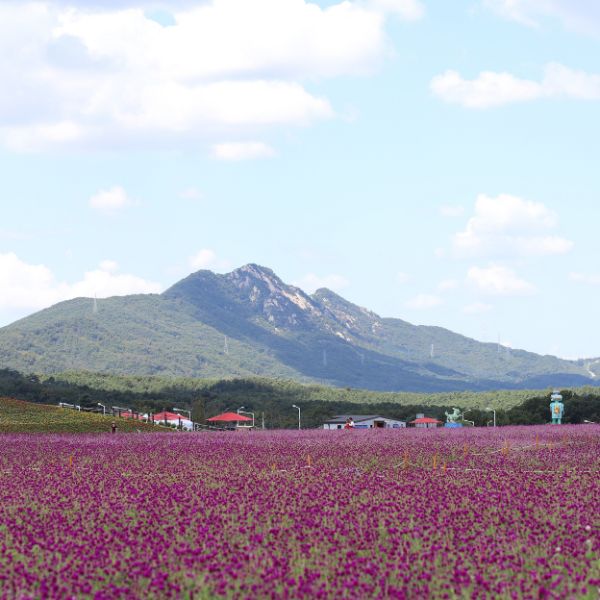
6: Yangju Nari Park
Yangju’s Nari Park isn’t a spot for autumn leaves, but I wanted to include it anyway as it’s a festival of colours and autumn flowers and a great place to spend a day out away from central Seoul.
Nari Park in Yangju is a haven of autumn plants and flowers, including Mexican fire brush, globe amaranth, and the ever popular pink muhly. Take a stroll through the pinks, purples, and reds of these fall flowers and look out at the mountains.
Take the subway to Yangju Subway Station (Line 1 – Dark Blue). Take the local bus 2-4 and get off at Mansong-dong 1-tong, or take a taxi to this address – 경기도 양주시 만송동 산46.
Address in Korean: 경기도 양주시 만송동 산46
Tour Options: There is a tour that combines Nari Park with a few other Korean sightseeing spots, including Dumulmeori.
Nari Park, Pink Muhly Grass, and Dumulmeori Day Tour – ₩63,000
7: Jeonju Hanok Village
Jeonju Hanok Village is Korea’s must-see hanok village outside of Seoul and features over 700 traditional hanok houses and other historic sights, such as the Jeondong Cathedral. Thanks to the traditional Korean architecture, wide streets, and numerous trees around the Jeonju Hanok Village, it’s especially pretty during autumn.
You can see loads of golden leaves stretching out over the black-tiled rooftops of the low hanok buildings. For the best views, head to the Omokdae (오목대) hilltop lookout. Don’t forget to rent Korean hanbok for the ultimate Korean foliage pictures.
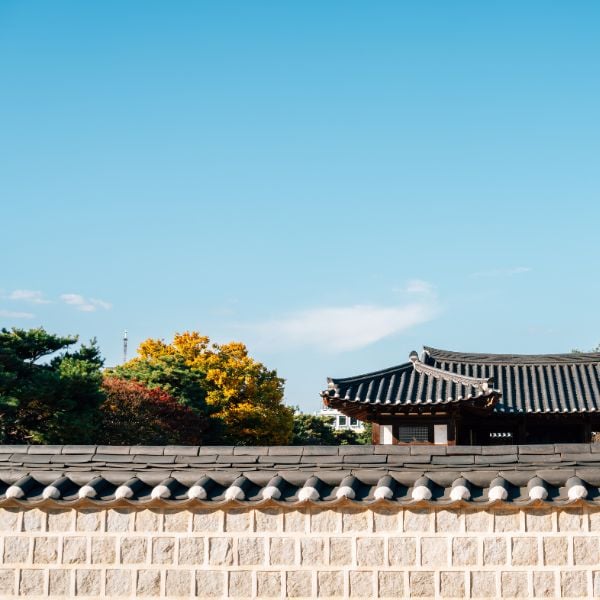
Train from Seoul: Take the KTX train from Yongsan Station in central Seoul to Jeonju Station. From outside the main entrance of the station (west), take any of the buses heading to Jeonju Hanok Village (전주 한옥마을). Bus to Jeonju Hanok Village include 6, 79, 108, 199, 535.
Bus from Seoul: Take a bus from Seoul Central Bus Terminal (센트럴시티터미널) to Jeonju Express Bus Terminal (전주고속버스터미널). From the terminal, take bus 8-2, 165, 350, 1001, 5001, or 6001 to the Jeonju Hanok Village. Alternatively, take a taxi as it’s a short distance.
Tour Options: Take a day trip from Seoul to Jeonju to see autumn leaves and try traditional Korean foods that Jeonju is famous for, such as bibimbap. Here are some available tours:
Where To See Autumn Foliage In Korea National Parks
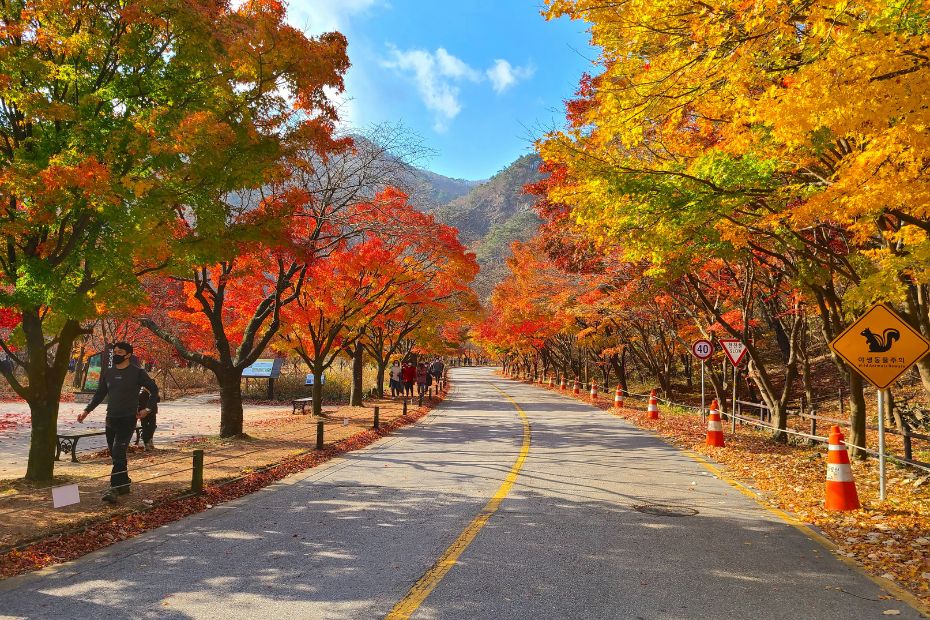
Korea’s national parks are without a doubt the best places to see foliage sights in autumn thanks to the abundance of tree-covered slopes and leafy valleys they have. There’s so much to see and do in these parks, too. You can hike, explore Buddhist temples, or just sit back and take in the views.
Here are 8 incredible national parks to visit in Korea for autumn foliage views:
1: Naejangsan National Park
Naejeangsan National Park is one of the must-see places for autumn leaves in Korea for many reasons. Naejang, meaning ‘many secrets’, is packed full of delightful presents. From the fiery colours you’ll see passing through the Maple Tree tunnel, to the golden gingko leaves surrounding Naejangsa Temple, this park has an impressive array of photo-worthy locations.
You’ll also want to see the Uhwajeong Pavilion, located inside a crystalline lake and surrounded by leafy slopes of warm fall foliage. Besides this, you will find several waterfalls, wonderful Buddhist temples, and hundreds of different plants and animals.
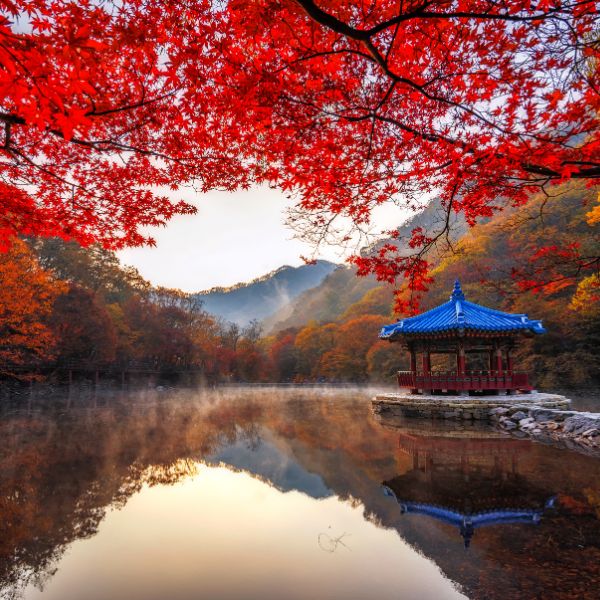
To get to Naejangsan National Park, travel to Jeongeup Station (정읍역) on the KTX and then transfer to a local bus to get to the park. You can also book intercity buses to Jeongeup City or tour buses that will take you directly to the park.
For more details about how to get to Naejangsan, as well as more pictures of Naejangsan in autumn, check out my guide about how to go to Naejangsan National Park.
Tour Options: Take a day trip from Seoul or Busan and explore the beauty of Naejangsan and it’s hidden treasures as you walk around the park. Here are a few tours available this autumn:
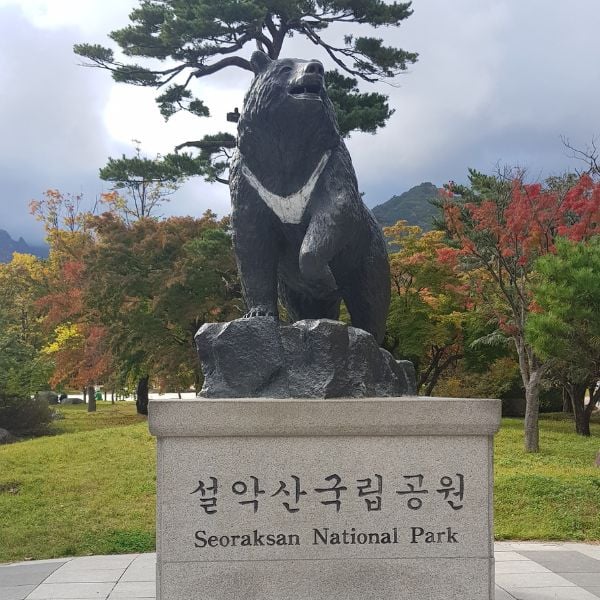
2: Seoraksan National Park
Hiking Seoraksan is a real treat and this national park is one of the most convenient for beautiful fall foliage viewing from Seoul. Situated near the northeastern coast, this is also one of the first places to see the autumn leaves in Korea.
Seoraksan is packed full with stunning rocky peaks, the most important Buddhist temple in Korea, and plenty of ways to explore it all. There’s a large range of trails for all levels and seeing it all from the bottom is worth the trip alone. If you want to explore the mountain range more comfortably, take the Seorak Cable Car.
Take an intercity bus from Dong-Seoul Bus Terminal or the Seoul Express Bus Terminal to Sokcho Intercity Bus Terminal. From here, transfer to bus 7 or 7-1 towards Seoraksan National Park. For full details about getting there by car, bus, or tour, check out my guide to Seoraksan National Park.
Tour Options: Tours from Seoul to Seoraksan also visit Nami Island and other attractions that are between the two locations. There are also tours that only go to Seoraksan, giving you more time in the park.
3: Jirisan National Park
The largest national park in Korea offers so many chances to see Korean autumn leaves. Packed full of maple trees and other fall foliage, as well as small villages, wild animals, and mountains, this is an all-round experience not to be missed. Jirisan National Park is great for all levels of hikers & trekkers.
There are many easy courses that anyone can walk, including a 16-stage loop around the national park.You can book lodges to stay overnight on the mountain and lower down the mountain which can be used as a stopping point between day hikes / treks.
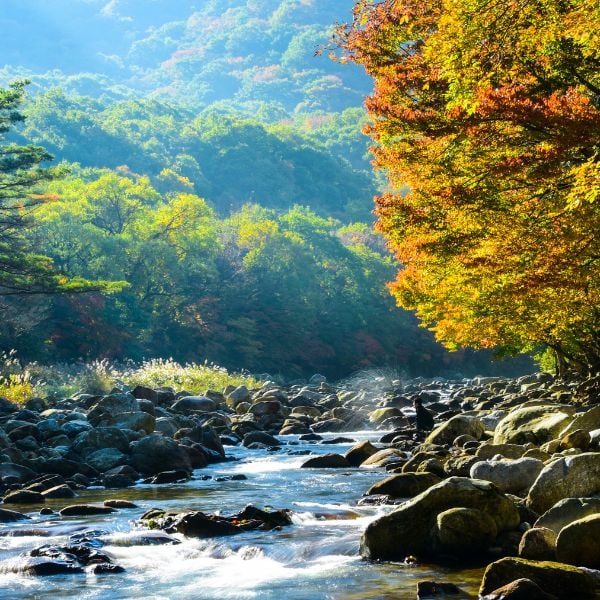
Jirisan is best accessed from Busan or other southern cities, or by car from Seoul. You can also access the entrances to Jirisan by bus from cities such as Jeonju, Gwangju, Daegu, and Daejeon
Bus from Busan & Daejeon: From Seobu Terminal in Busan take buses heading for Ssanggyesa (쌍계사) or Gurye Bus Terminal (구례공영버스터미널). From Daejeon Bokhap Terminal take a bus heading for Namwon Bus Terminal (남원공용버스터미널)).
Change to local buses to the park from those towns. I recommend using Naver Map to check the route for the day you want to travel, but be warned that there aren’t many buses in these areas.

4: Bukhansan National Park
Bukhansan National Park provides great options for hiking and enjoying fall foliage. There are several hiking routes, with each one providing stunning views of northern Seoul and autumn’s splendour. My favourite one is the hike to Baegundae Peak, the highest peak in Bukhansan.
Hikes will take the best part of 3-5 hours to get to the top and back. The weather is cool at this time of year, which is perfect for hiking. If you’re only visiting Seoul, this is probably the most convenient place to see autumn leaves in Korea and try hiking at the same time.
Take the subway to Gupabal Station (Line 3 – Orange) and use exit 1. Take Bus 704 for Bukhansan-seong Fortress (or a taxi) and get off at the Bukhansan Fortress Entrance bus stop.
For full details about how to get to the various entrances of Bukhansan National Park, as well as the best courses to take, how to prepare for the hike, and lots more, check out my guide to hiking Baegundae Peak in Bukhansan National Park.
5: Odaesan National Park
Odaesan National Park is great for those who want to experience trekking and all the stunning autumn views you’d expect from a national park without having to hike up to the top of a mountain. Although you certainly can and should reach the peak if you’re up for it.
Odaesan’s Seonjae-gil Road is a 10km trekking path that follows the valley floor through lush autumn foliage. The start location, Woljeongsa Temple, also includes another treat, a fir tree-lined street. Fans of K-drama may recognise it from the hit show ‘Goblin: The Great and Lonely God’.
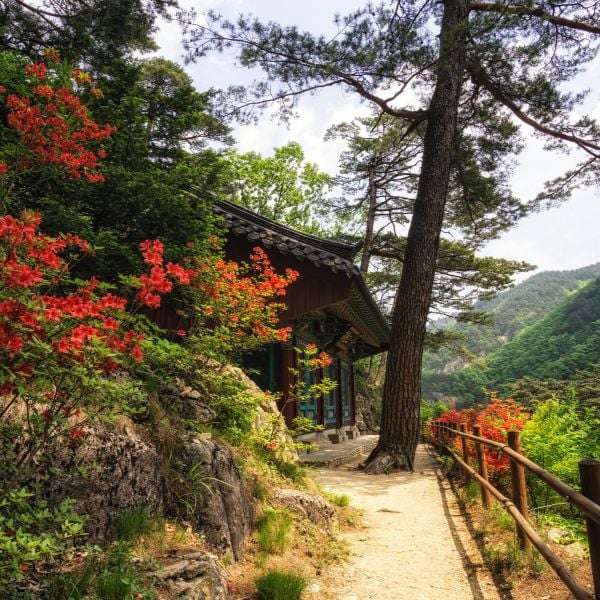
Take the intercity bus from Dong-Seoul Bus Terminal to Jinbu Bus Terminal (진부시외버스터미널), which takes about 2 hours. From Jinbu Bus Terminal, take bus 225 or 226 towards Woljeongsa (월정사) or to the Sangwonsa Temple Bus Stop (상원사), which is closer to the hiking trails.
Alternatively, take a taxi straight to the park entrance, which will cost about 30,000 KRW.
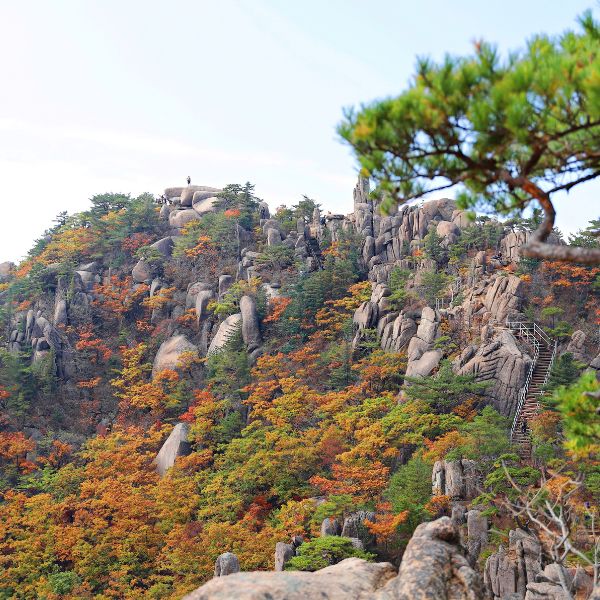
6: Gayasan National Park
Gayasan National Park is a great place to hike and see autumn leaves for people in Busan. This national park explodes with colour from mid-October, with grey boulders from the rocky mountains providing a stark contrast of views. Culture lovers will also enjoy visiting Haeinsa Temple, a UNESCO World Heritage Site and very impressive temple that’s worth the visit alone.
Like Jirisan, the most prominent type of tree on display in autumn is the maple tree, with each tree showing off thousands of small, spiky leaves that can often include green, yellow, and red leaves on the same tree.
Bus from Daegu: Take the bus from Daegu Seobu Intercity Bus Terminal directly to Haeinsa Temple. Takes about 1 hour. Travellers from Seoul and Busan should transfer in Daegu to get to Gayasan.
Bus from Daejeon: Take the intercity bus from Daejeon to Haeinsa Temple. Here’s more information about how to get to Gayasan.
7: Hallasan National Park
Hallasan Volcano, rising up out of the ocean to create Jeju Island, provides an incredible hiking experience. It’s also one of the last places to see the autumn leaves in Korea as the cold weather makes its way through Korea, touching Jeju Island just before winter sets in.
Don’t worry, you won’t have to climb the highest mountain in Korea to see the fall foliage. Shorter routes around the base of the mountain will give you great views of autumn’s splendour and leave you enough energy to enjoy Jeju’s other sights.
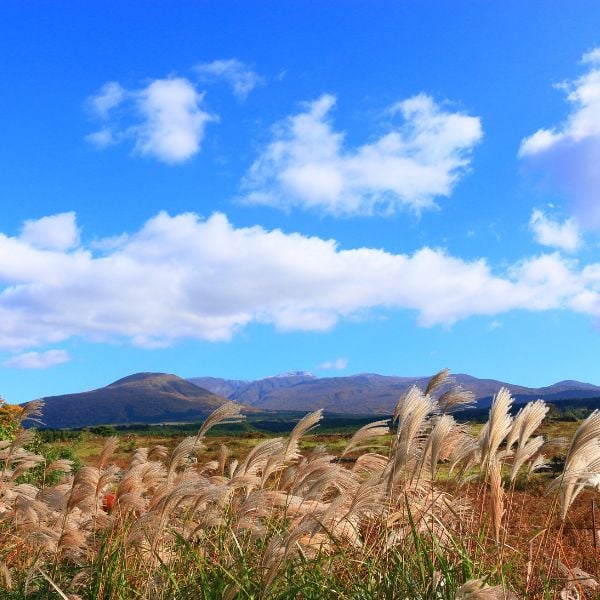
There are 4 different paths to climb in Hallasan National Park and they can all be accessed by taxi or public transport from either Jeju City, Jeju Airport, or Seogwipo City.
Here’s a quick summary of the 4 main trails:
- Gwaneumsa Trail: 8.7km (one-way) 8-10 hours total hike
- Seongpanak Trail: 9.6km (one-way) 7-9 hours total hike
- Eorimok Trail: 4.7km (one-way) 2.5 hours return hike
- Yeongsil Trail: 3.7km (one-way) 2 hours return
Wherever you go, make sure to start hiking early as the trails close to new hikers after 12:00pm.
If you’re brave enough to hike to the top of Hallasan, you’ll need to make a reservation. Personally, I think winter is the best time to hike Hallasan, which I’ve done for the last couple of years. I’ve put together a guide to hiking Hallasan in winter with lots of pics of the snow-covered volcano. Here are some more ideas about what to do if you end up on Jeju Island in winter.
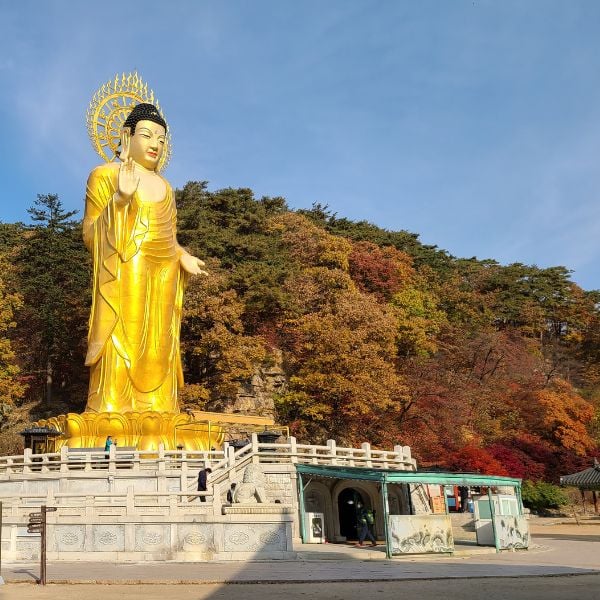
8: Songnisan National Park
Located in the heart of Korea, Songnisan National Park was one of the first national parks in Korea and remains one of the best, especially for an all-round autumn experience that includes hiking, traditional food, and an impressive Buddhist temple.
The hiking trails take you from the historic Beopjusa Temple, with a gigantic standing golden Buddha, past shaded streams, a lush valley floor, and up into the moderately high peaks. There are lovely fall sights at every step and peaceful restaurants to enjoy the views in as you hike.
Bus from Daejeon: Take the intercity bus from Daejeon Bokhap Terminal (대전복합버스터미널) to Songnisan Bus Terminal (속리산터미널) and walk towards the restaurants and cafes that lead to the start of the hiking courses. From other cities, head to Daejeon and transfer there.
When visiting Songnisan, why not stay in a Korean Buddhist temple? A Korean temple stay is an incredible experience and Beopjusa Temple is one of my favourite temples. You can book a weekend away sleeping in the temple grounds and wake up to see sunrise in the mountains.
Where To See Autumn Leaves In Busan 2024
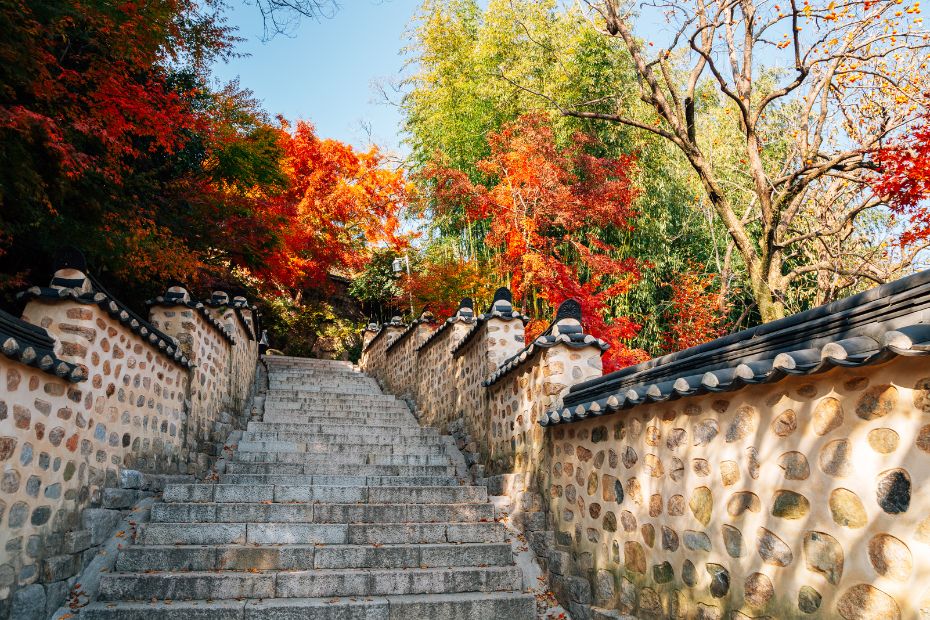
Busan is a charming coastal city on Korea’s south coast that’s famous for summer activities like surfing, swimming in the ocean, and relaxing on the beach. However, there are also lots of places to see autumn leaves in Busan, especially in the mountains, parks, and temples that surround the city.
If you want to see autumn foliage in Busan in 2024, you don’t have to go far from the main areas of Haeundae or Seomyeon to find them. Wide riverside pathways that wind their way to the sea are lined by trees with colourful foliage on both sides. There are even autumnal scenes along the coast.
Here are some of the amazing places you can see autumn leaves in Busan:
Temples In Busan
Busan is famous for the stunning cliffside Haedong Yonggungsa Temple, but if you want to see autumn leaves at a temple in Busan, you should visit Beomeosa Temple (범어사). You can see the foliage-covered slopes of Geumjeongsan Mountain when you visit Beomeosa and there are golden gingko trees in the park, too. Another beautiful temple to visit in Busan during autumn is Samgwangsa Temple (삼광사), which provides clear views over Busan from Baegyangsan Mountain.
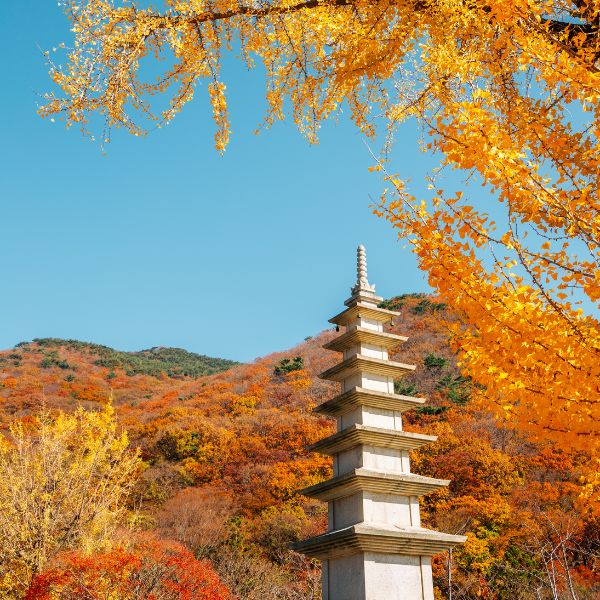
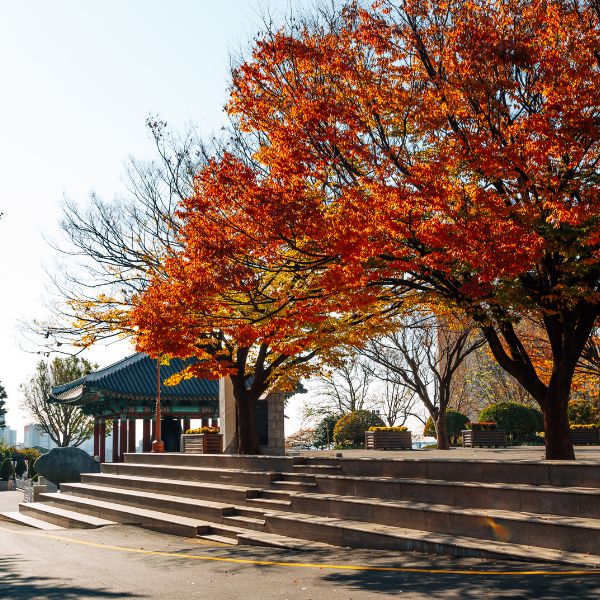
Eco Parks In Busan
Busan is has many eco parks and green spaces where people can reconnect with nature. During autumn, Busan’s eco parks are ideal for seeing autumn leaves, pink muhly, and silver reeds. Daejeo Eco Park (대저생태공원) and Samnak Eco Park (삼락생태공원) in Busan’s Sasang District are perfect for an afternoon walk through tall reeds and under leafy trees. Further down the river is Eulsukdo Eco Park (을숙도), located on a small island where the river flows into the sea. This park is perfect for picnics and watching the sun set.
As well as eco parks, there are hilltop and family parks where you can see autumn leaves in Busan. Busan Children’s Grand Park (부산어린이대공원) has the most impressive autumn views as it looks out over Seongjigok Reservoir and the slopes of Baegyangsan Mountain. Other parks to see autumn leaves include Yongdusan Park (용두산공원), home to Busan Tower, Yeonji Park (김해연지공원) in Gimhae, and Jungang Park & Democracy Park (부산민주공원), which has views of the whole city.

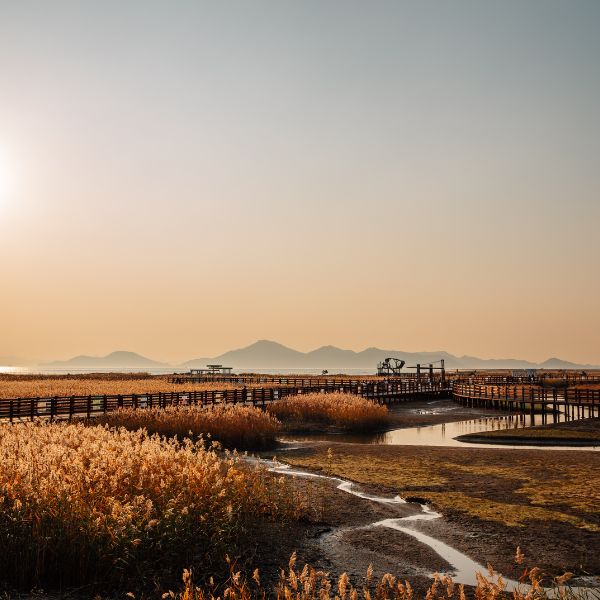
River & Coastal Views
There are several lovely waterside places where you can enjoy blue skies, flowing water, and autumnal views in Busan. One of my favourite is Oncheoncheon Citizen’s Park (온천천시민공원) – a tree-lined riverside pathway that runs all the way to Millak Park and Gwangalli Beach. There’s also Dadaepo Beach Park (다대포해변공원) that has millions of silvery reeds waving in the wind. For gorgeous autumn sunset views, visit this park in the evening.
I haven’t included directions to each of these locations, but I have linked the location of each place from Naver Map – the most reliable map app in Korea. You can use this link to help you plan how to get to each place either on the day or in advance.
Download Naver Map and click the link, then plan your route from your desired start location. You can see routes by public transport, car, and by foot and the app will tell you how long it will take and when the next bus / subway is due. It will also show you the expected taxi price to get there.
Where To See Autumn Foliage In Gyeongju 2024
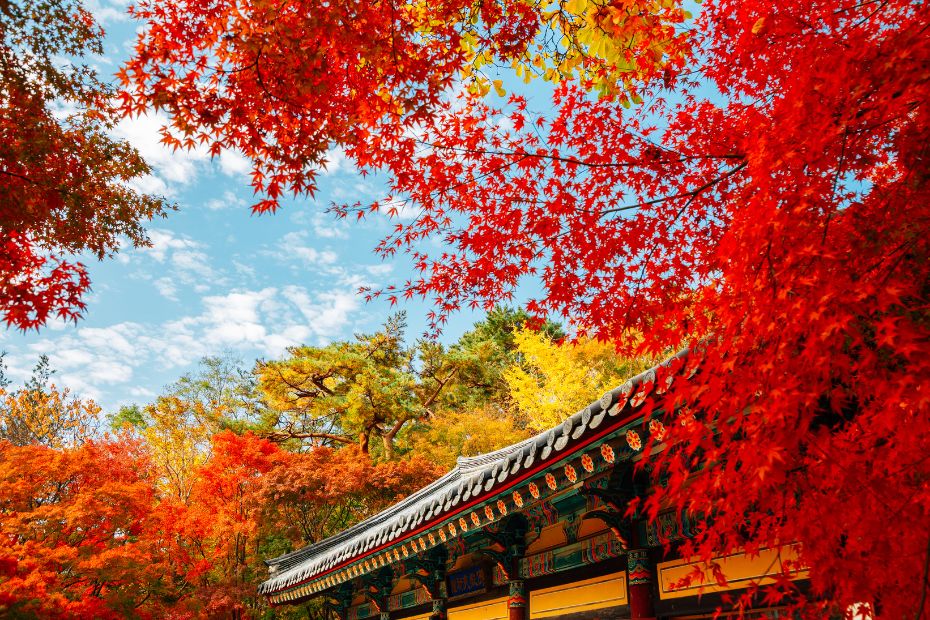
Autumn is a fantastic time to visit Gyeongju for several reasons, not least of all are the magnificent autumn colours you can see at Gyeongju’s many famous sights. The blue skies and cool weather of autumn also make this the ideal time to visit Gyeongju, where most of the sites are outdoors.
Visitors to Gyeongju in autumn can see pink muhly next to Cheomseongdae Observatory, walk down a leafy pathway between Seokguram Grotto to Bulguksa Temple, and see silver reeds and autumn trees stretching around the wide Bomun Lake. That’s not to mention all the traditional hanok houses, too.
Gyeongju isn’t a large city and you can see most of the top sights in one or two days. I recommend a two-day stay if you want to visit Gyeongju in autumn so you can see more and enjoy the night sights that are available – both traditional and modern. Day tours from Busan are also convenient.
Here are the best places you can see autumn foliage in Gyeongju:
Autumn In Central Gyeongju
Gyeongju is known as an outdoor museum due to the wealth of historic artefacts on display in this UNESCO World Heritage City. The best place for autumn sights in Gyeongju is the sprawling Gyeongju Historic Area, home to Cheomseongdae Observatory (pictured). This area is packed with famous sights and is surrounded by nature, including pink muhly, silver reeds, and autumn foliage. You can spend several hours walking around this area and not get bored of the history, culture, and natural wonder on display.
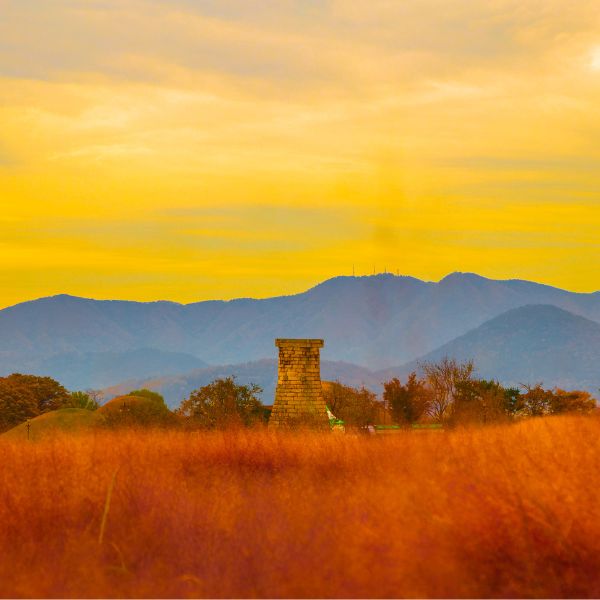

Make sure to head to Woljeonggyo Bridge and the Gyochon Traditional Village for pretty pictures by the river. From here you can walk along the road to the hilltop Gyeongju National Museum for more autumn views below. A short walk from the museum is the Donggung Palace & Wolji Pond, which is best visited at night for illuminated autumn leaves and amazing reflections in the water. Another pleasing autumn leaves sights in central Gyeongju is Bunhwangsa Temple (pictured).
Autumn In Outer Gyeongju
The best autumn views in Gyeongju are outside the city centre, located in Bulguksa Temple (불국사) – a 1,500 year old temple complex in the foothills of Tohamsan Mountain. Bulguksa is blessed with autumn foliage sights inside and out. See weeping willows, vibrant maple leaves, and golden gingko trees contrast spectacularly with bright greens of traditional Korean temple architecture. I recommend starting at Seokguram Grotto (석굴암) at the top of Tohamsan Mountain and following the shaded path down to Bulguksa Temple.
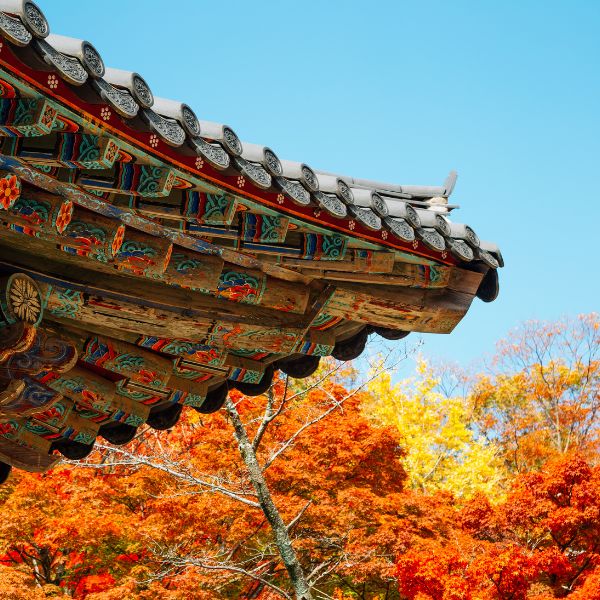

The Bomun Tourist Complex in Gyeongju may be one of the best places to see Korean cherry blossoms, but it’s also beautiful during autumn and definitely worth visiting. The main attraction is Bomun Lake and the pathways that go around its edge. You’ll find some cosy cafes and restaurants on the lake’s shores, perfect for sitting and enjoying the autumn scenery. Also check out the unique Jungdo Tower (황룡원중도타워), a recreation of the gigantic 9-storey wooden pagoda of Hwangnyongsa Temple.
Train from Seoul: Take the KTX from Seoul to Singyeongju, then take a local bus to the Gyeongju Express Bus Terminal to get closer to the city centre. This takes about 2 hours and 20 minutes and costs around 50,000 KRW one way.
Bus from Seoul: Take the bus from the Seoul Express Bus Terminal (서울고속버스터미널) – Gyeongbu Line – to Gyeongju Express Bus Terminal (경주시외버스터미널). This takes about 3 hours and costs around 42,000 KRW one way. You can book bus tickets on the KOBUS website.
Bus from Busan: There are buses from Busan Central Bus Terminal (부산종합버스터미널) to Gyeongju Express Bus Terminal (경주시외버스터미널) every hour. The journey takes about 50 minutes and fares are around 6,000 KRW. You can book bus tickets on the KOBUS website.
Tour Options: An easy way to see autumn foliage in Gyeongju is with a day trip from. Due to the distance between top spots in Gyeongju, a tour is much more convenient than public transport. Also, you can learn about the sites from the guide. Here are some available tours to Gyeongju:
- Gyeongju The Old Capital of Korea One Day Tour from Busan – ₩80,000
- Gyeongju UNESCO World Heritage Tour from Busan – ₩91,300
- Gyeongju One Day Trip from Seoul (Optional Drop off in Busan) – ₩159,400
- Gyeongju Small Group Tour from Busan – ₩105,000
Lesser-Known Autumn Leaves Spots In Korea
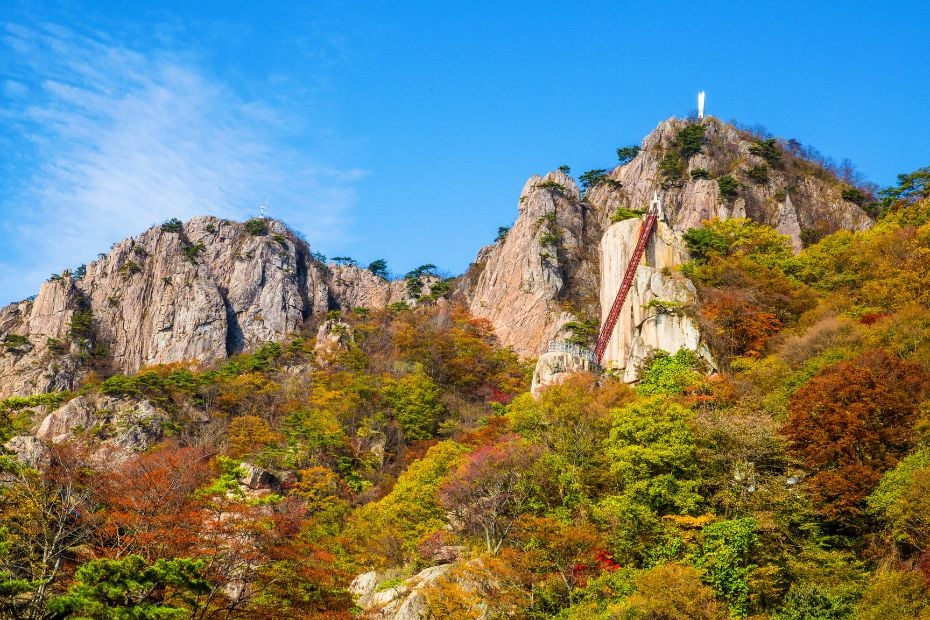
This final section to this guide to seeing autumn foliage in Korea is dedicated to the lesser-known autumn foliage sites outside of the national parks and big cities. These are foliage spots that I’ve discovered while hiking in Korea or been told about by locals that I want to share with you.
Here are 5 autumn foliage hotspots in Korea that are worth the journey:
1: Daedunsan Provincial Park
Daedunsan Provincial Park near Daejeon is a joy to visit for autumn leaves and the unique attractions you can see when hiking. For those only interested in the sights, take the cable car to the top of the mountain. Don’t worry, you won’t miss out on the best parts of the mountain, such as the suspension bridge passing between two rocky slopes with autumn views below. Just before the peak, you can climb a near vertical ladder over a sheer drop to another peak. Known as the Cloud Bridge, this is not for faint-hearted people, but provides amazing views.
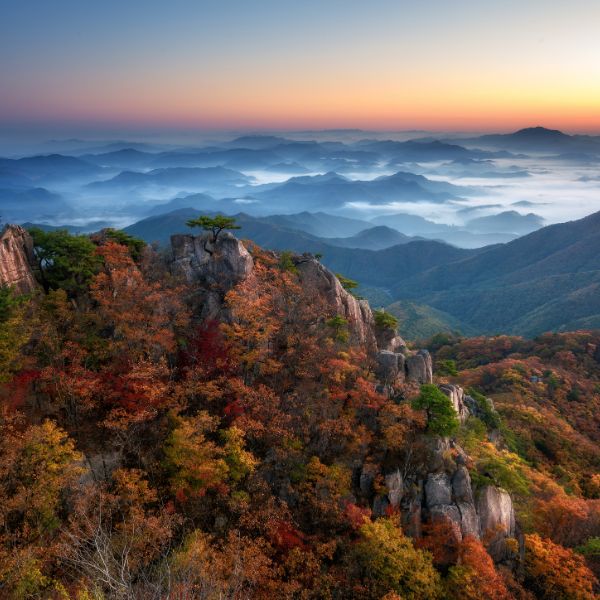
Bus from Daejeon: Depart from Seo-Nambu Bus Terminal (대전서남부터미널) in southern Daejeon and take Bus 34 to the Daedunsan Rest Stop. Walk 10 minutes down the road to get to the park entrance. You’ll see a cable car running up the side of the mountain. If in doubt, head for that.
Another great option for autumn leaves close to Daejeon is Gyeryongsan National Park – one of my favourites. You can find out about hiking both these places from this guide to hiking in Daedunsan and this guide to hiking in Gyeryongsan.
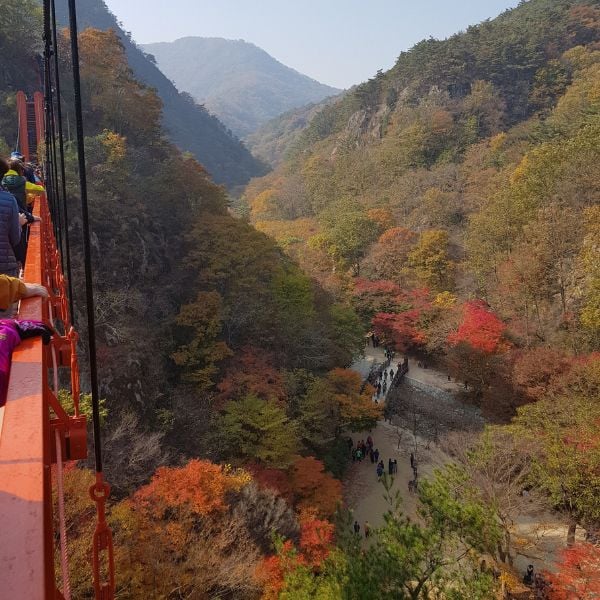
2: Gangcheonsan County Park
A popular place with Koreans, but not well known by tourists, is the culturally and nature-rich Gangcheonsan County Park. Hidden away in Sunchang, this large park has lush valleys lined with thick, bushy trees that turn red, yellow, and orange during fall and tall hills bedecked with resplendent fall foliage.
Inside Gangcheonsan you’ll find cultural wonders such as Gangcheonsa Temple, the Geumseongsanseong Fortress, and the Gancheongsan Five-story Stone Pagoda. The best site is the suspension bridge hanging above the valley, which offers trekkers the chance to see these autumn leaves from high above.
Bus from Seoul: Take a bus from Seoul Central Bus Terminal (센트럴시티터미널) to Sunchang Bus Terminal (순창공용버스터미널). From the terminal, take a local bus bound for Jeongeup or Gurim (순찬 – 정읍 – 쌍치 line) and get off at Gangcheonsan Mountain Bus Stop (강천산임시치안센터).
Alternatively, ask a taxi driver at the Sunchang Bus Terminal to take to take you directly to the Gangcheonsan County Park by showing them this name – 강천산군립공원
3: Mindungsan Mountain Trail
There’s more to autumn leaves in Korea than maple trees and gingko trees. Autumn is also a time to see willowy silver grass – tall reeds that create white waves atop mountains, rivers, and lakes across Korea. These reeds are a symbol of autumn and you’ll find a whole mountain’s worth of them at the Mindungsan Mountain Trail, which has its own festival from mid-September to early November, celebrating these special reeds. There’s also plenty of autumn leaves to see on the hike to the top, which is where the reeds are on display.
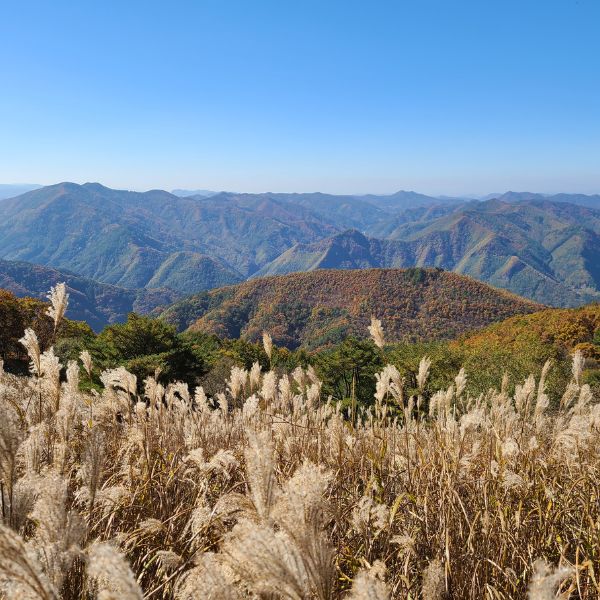
Take a train from Cheongnyangni Station (청량리역) in Seoul to Mindungsan Station (민둥산역) – it’s on the Mugunghwa Line (slow train) to Taebaeksan. Exit the station and head down the hill towards the Mindungsan Trail Car Park (민둥산등산객전용주차장).
The entrance is clearly signposted and starts on the opposite side of the road from the car park. It should take about 10-15 minutes to walk from the station to the trail entrance.
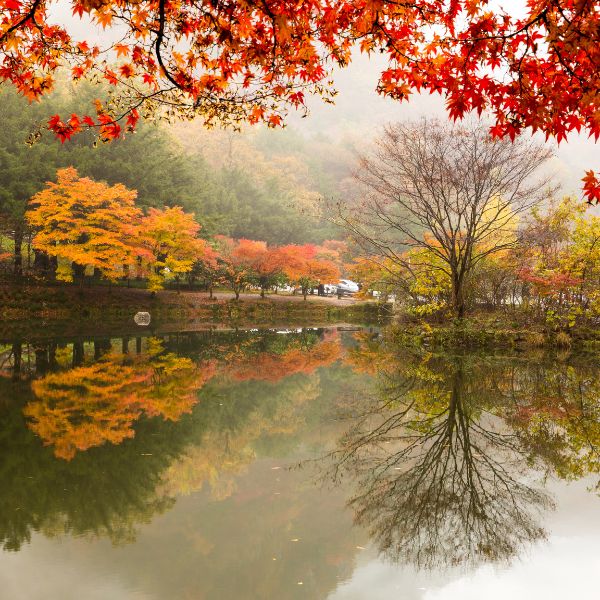
4: Seonunsa Temple
Located far away in Seonunsan Provincial Park is one of the best places to see autumn leaves in Korea if you have a car – Seonunsa Temple. This hidden temple is almost 1,500 years old and due to it’s remote location, feels like you’re transported back in time to a more natural past. During autumn, take a stroll along the picturesque Dosolcheon Stream and see fallen foliage floating by, see the bright reds and yellows spreading over the hills behind the temple, and see the many historic artefacts and treasures in the temple.
Bus from Seoul: Take a bus from Seoul Central Bus Terminal (센트럴시티터미널) to Heungdeok Bus Terminal (흥덕공용버스터미널) in Gochang. From the terminal, take a bus to Seonunsa Temple (선운사) on the 흥덕 – 해리 line. Get off at the Seonunsan Bus Stop (선운산버스정류장).
Please note that by public transport the journey from Seoul will take about 4 hours. Driving is much faster and definitely recommended.
5: Damyang Metasequoia Road
The 8.5km Damyang Metasequoia Road is one of Korea’s loveliest pathways, especially in autumn when the trees turn golden brown and drop their leaves. Metasequoia are famed for their tall height, rising high above the road and creating a tunnel for people to pass under with rays of sunlight sneaking through to add a touch of illumination. This road is close to another top Damyang attraction – the Juknokwon Bamboo Garden.
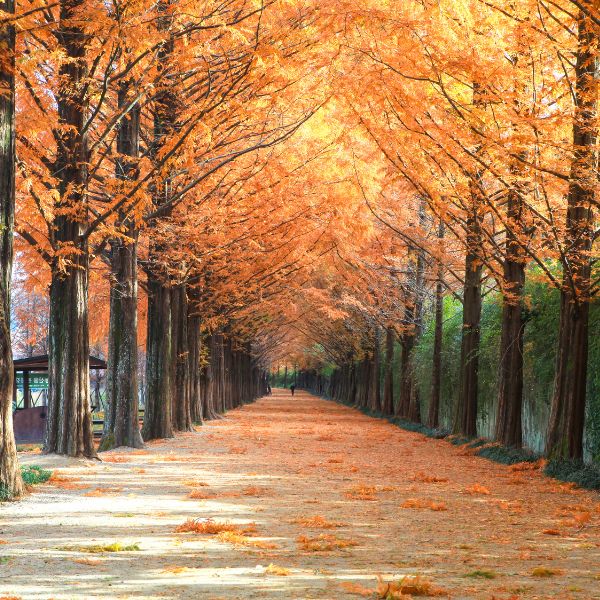
Bus from Seoul: Take a bus from Seoul Central Bus Terminal (센트럴시티터미널) to Damyang Public Bus Terminal (담양공용버스터미널). From the terminal, take bus 13-4 towards the Metasequoia Road (메타세쿼이아 가로수길)
Please note, the bus from Seoul takes 3:30. I recommend visiting this location from a closer city, such as Gwangju, or driving there.
Guide To Visiting Korea In Autumn 2024
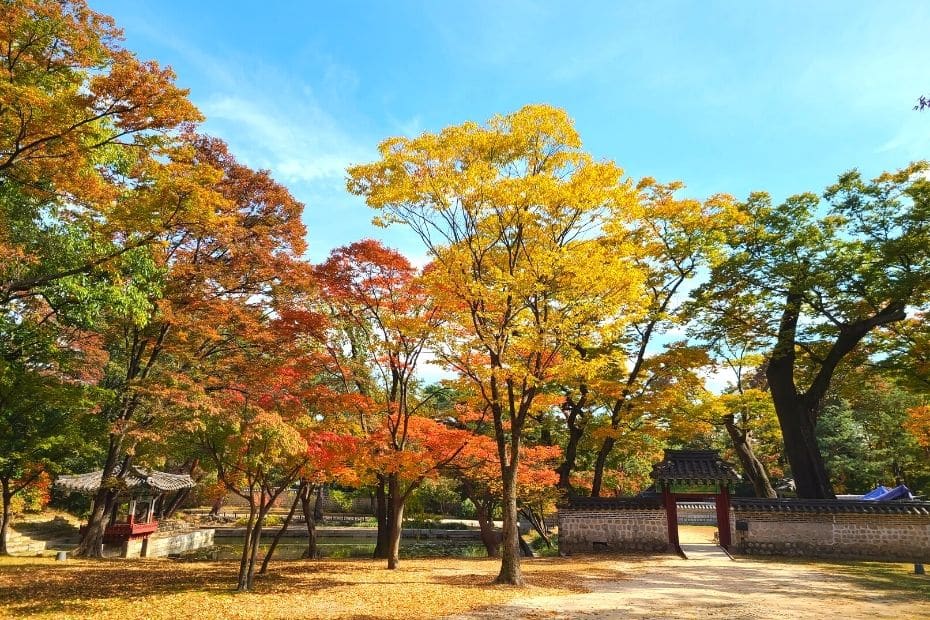
If you’re interested in hiking during autumn, which I would really recommend, then check out my guide to hiking in Korea, featuring lots of great tips all about Korea’s number 1 outdoor pastime.
Here are a few more tips to help you get the most out of your time seeing autumn leaves in Korea, such as what the weather is like, what to wear, and how to travel to see fall foliage.
Why Autumn Is The Best Time To Visit Korea
Korea has 4 very distinct seasons, ranging from really hot and humid summer (40+ degrees) to a freezing cold winter (-18 degrees). Spring and autumn are short, but packed full of opportunities to travel.
Although spring has cherry blossoms to see, autumn is the best for me due to the better weather, lower air pollution (which peaks in spring), and the feeling of relief that comes with the cooler weather after a long, tough summer.
If you want to travel to Korea, September to early November are definitely the best times to travel. You’ll see autumn leaves, get to enjoy local foods and fresh produce, and witness a lot of festivals and public holidays.
Autumn Weather In Korea
The weather in autumn ranges from hot and humid in early September (30 degrees) to freezing cold by mid-November. October temperature range from 15 to 25 degrees during the day, but can fall below 10 degrees at night. November is much colder.
Typhoons during September and October can change the weather very quickly, and rain showers or strong winds can appear one day and be gone the next, leaving the spectacular skies you can only see at this time of year.
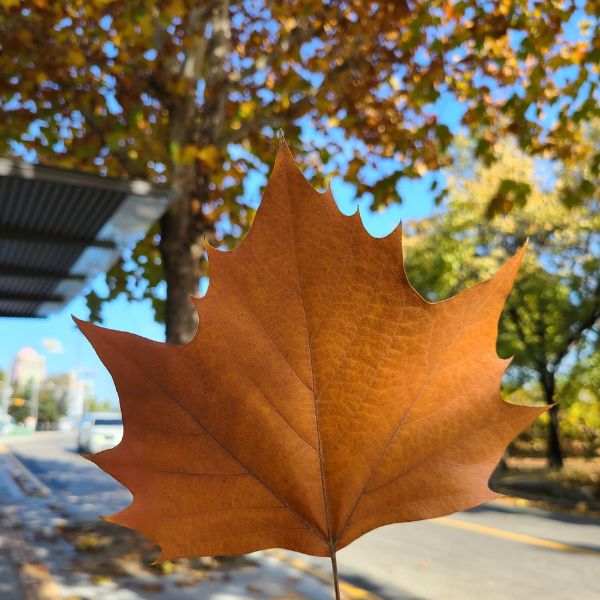
What To Wear During Autumn In Korea
Because the temperature can change quite a lot from morning to night, I’d recommend packing a light jacket or sweater to keep you warm after the sun sets. Lighter clothes should be fine during the day until mid-October, after that it’s time for more layers.
How To See Fall Foliage In Korea
The best way to see fall foliage in Korea is to get out into the mountains and national parks and try hiking. You don’t need to be a seasoned hiker to experience the best of the leaves, and in fact you don’t want to go too high as the best views are in the valleys.
Most national parks have walking trails through the valleys that can range from a couple of kilometres up to 10km (at Odaesan) of forest trails.
Alternatively, head to the historic sites across Korea, such as the royal palaces in Seoul, fortresses, or historic cities such as Gyeongju or Buyeo. Here’s a guide to visiting Buyeo in case you end up going.
Visiting Korea In Other Seasons?

Can’t travel to Korea in autumn?
No worries, Korea is an amazing country to visit any time of year and undoubtedly has four very distinct seasons with lots of other activities, sights, foods, and festivals waiting for you in each one.
Spring: Spring is all about the new blossoms and nature returning for the new year. The biggest thing to do in spring is to see cherry blossoms in Korea. From royal palaces to riverside walkways, there are loads of places to enjoy the fresh nature. There are also lots of fun spring festivals in Korea.
Summer: A hot and rainy time of year, but perfect for getting out to enjoy the best Korean summer activities, such as water sports, camping by the beach, summer festivals, eating yummy Korean summer foods, and getting a tan. If the rain is too heavy, there are plenty of indoor activities in Seoul where you can stay dry and still have fun.
Winter: After the beauty of the fall foliage and the rains of summer, winter is the complete opposite – snowy white and extremely dry. Winter has very little rain, which makes it perfect for exploring outside and enjoying one of the many Korean winter activities. Just make sure you wrap up warm! If you’re visiting Korea in winter, I highly recommend check out my Jeju Island winter itinerary.
Frequently Asked Questions
Finally, here are a few FAQs about where to see autumn leaves in Korea, in case the above information didn’t cover enough for you. If you have any other questions you’d like to ask, feel free to leave a comment.
Where Can I See Autumn Leaves In Korea?
The best places to see autumn leaves in Korea are without a doubt in Korea’s national parks. There are national parks spread across the country, as well as dozens of smaller areas of natural beauty where you can see fall foliage.
Where Can I See Autumn Leaves In Seoul?
You can find autumn leaves in Seoul very easily as there are many green areas throughout the city. Some of the most popular spots are in the royal palaces in the heart of Seoul, especially Changdeokgung Palace. Seoul has many other places to experience fall foliage, including Seoul Zoo, Seoul Forest, along the banks of the Han River, and Namsan Tower.
What Is There To Do In Seoul In Autumn?
There are many autumn festivals in Seoul that coincide with the major holiday of the season, which is called Chuseok in Korea. When the autumn leaves appear, many people go hiking in national parks and walking in nature. Autumn is cool and has low levels of pollution, making it a great time to get outside and enjoy nature’s blessings. The evenings are still warm in early autumn, so many people in Seoul visit night markets in various locations, too.
What Should I Wear To See Autumn Leaves In Korea?
Autumn leaves start falling in late September and the weather cools significantly after the hot summer. You’ll need at least a light jacket and something appropriate to cover your legs and arms. If you want to see autumn leaves in Korea, you should be fine with regular shoes for walking around a city. However, if you want to see Korea’s fall foliage in the national parks, then you should wear training or hiking shoes that are comfortable in rough terrain.
How Cold Is Autumn In Korea?
Autumn in Korea starts in September and is still warm and humid. However, the temperature drops quickly and by mid-October it can be windy and cold enough for a jacket. By November the temperature drops further and starts to get below zero as Korea approaches winter. During peak autumn season time (October), temperatures are around 10-15 degrees Celsius during the day. There can be typhoons during this season, so be careful as there can be strong winds and heavy rains for brief periods. Otherwise, the weather is mostly calm and sunny.
When Can I See Autumn Leaves In Seoul?
The best time to see autumn leaves in Seoul is around mid-October as the trees start to change colour. The autumn leaves in Seoul should stay for several weeks and reach their peak around the end of October. Places close to Seoul, such as Seoraksan National Park, usually peak before Seoul.
When Can I See Autumn Leaves In Korea?
Autumn leaves in Korea first appear at the end of September in the north-east of Korea, before moving down through the country and reaching Jeju Island around mid-October. The start date is not the same as the peak date, which is when the autumn leaves will be most colourful.
Can I See Autumn Leaves In Korea During November?
There are several national parks in the south of Korea, including Jirisan National Park, Naejangsang National Park, and Hallasan National Park on Jeju Island. These should all still have autumn leaves on their trees by early-mid November. The last time you’ll see autumn leaves in Korea is the middle of November. After that, the weather drops quickly and winter in Korea begins.
Liked This? Pin It For Others
If you enjoyed reading this article, then please share this with your friends on Pinterest.
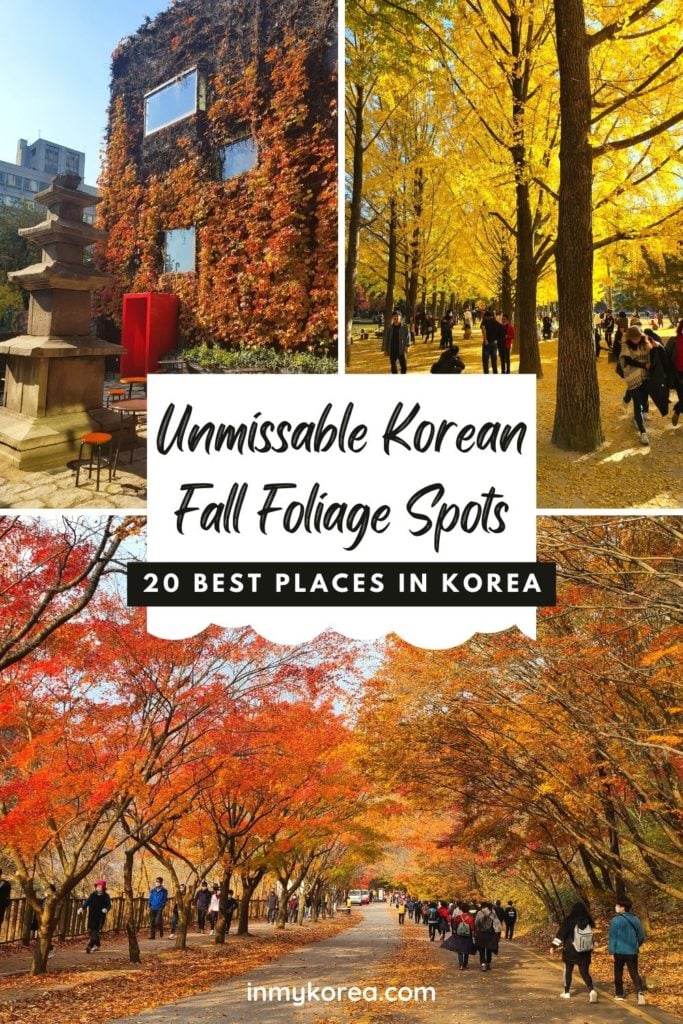
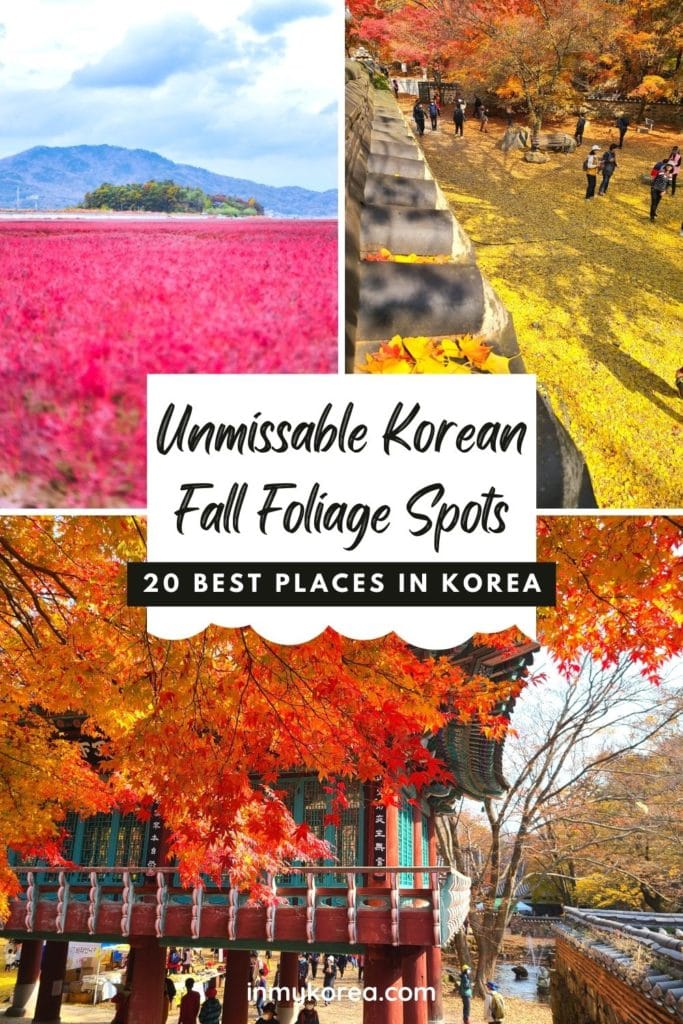
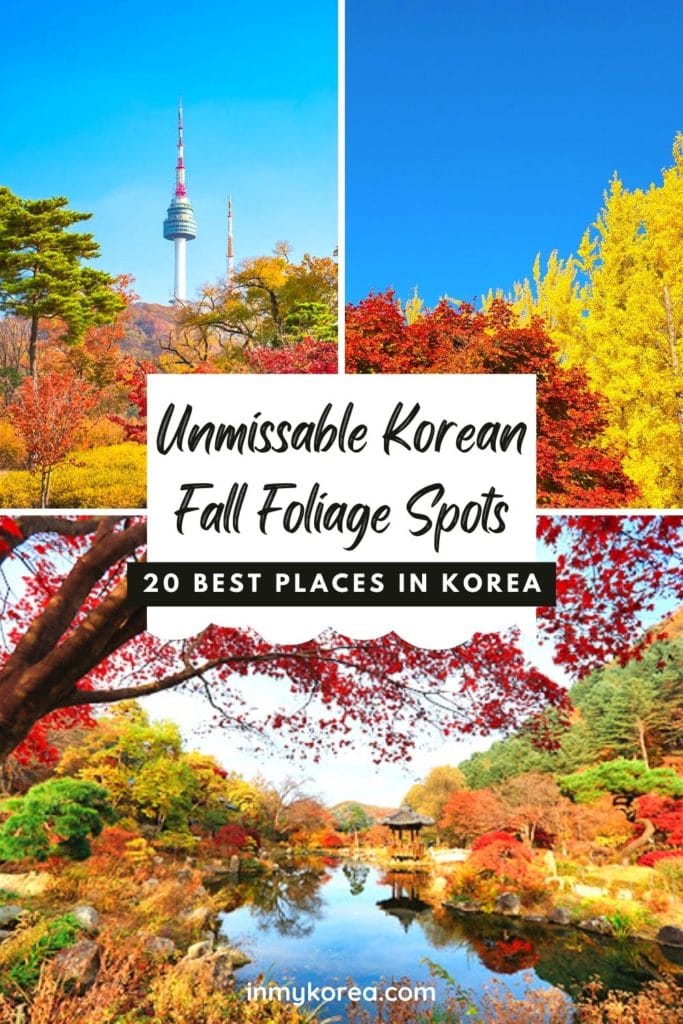
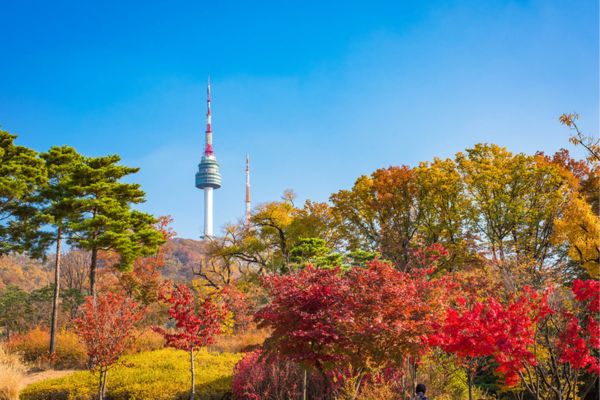

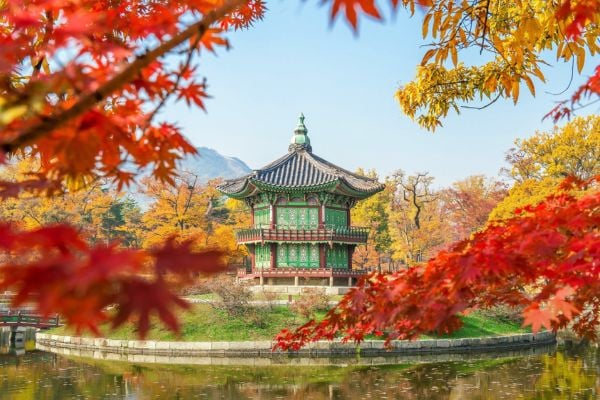
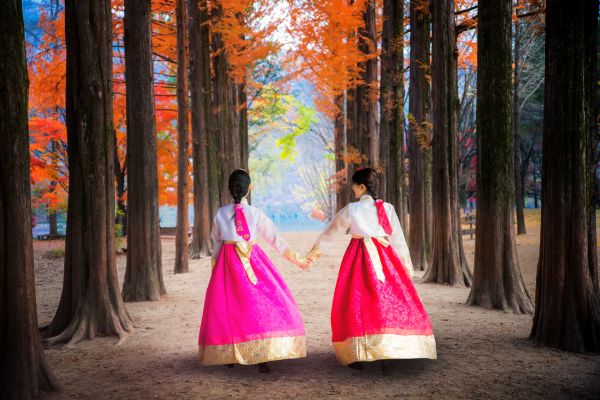
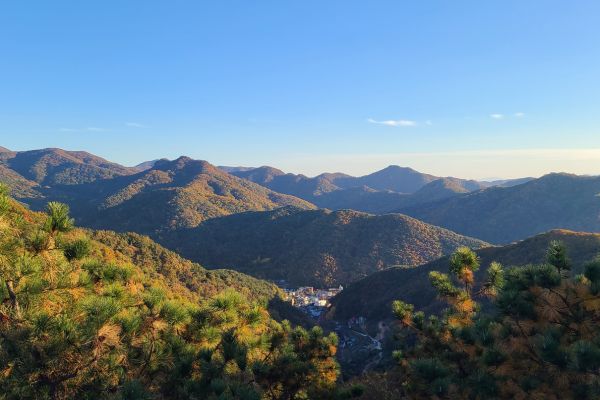
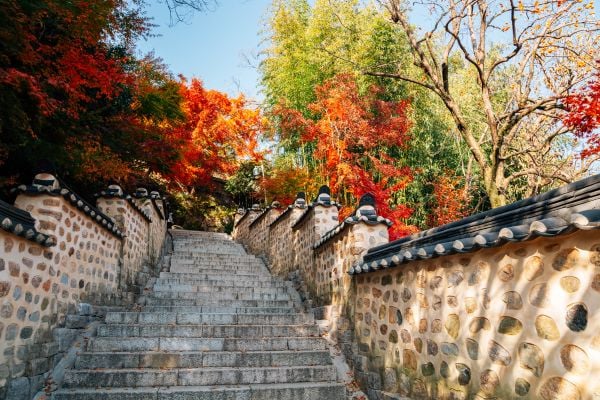
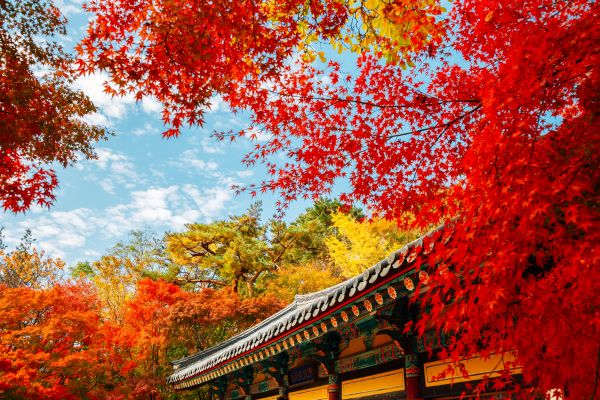
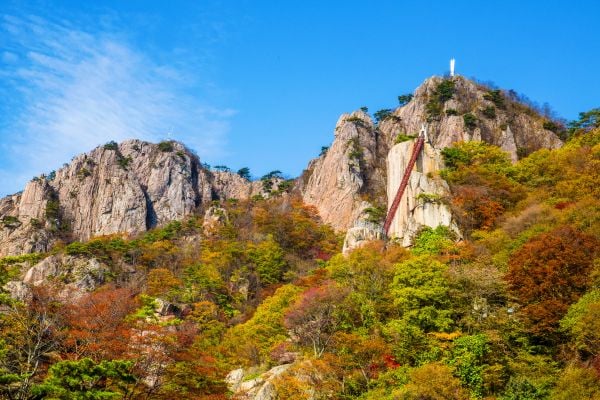
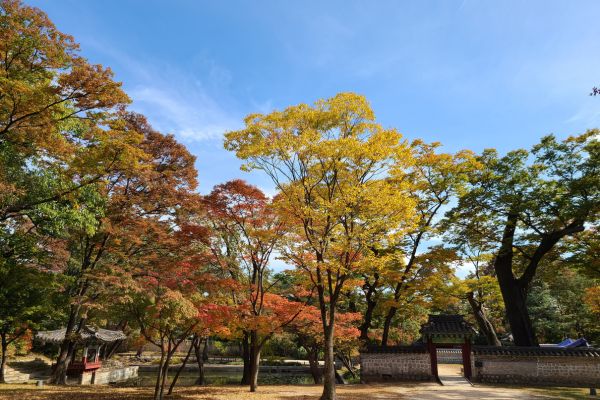


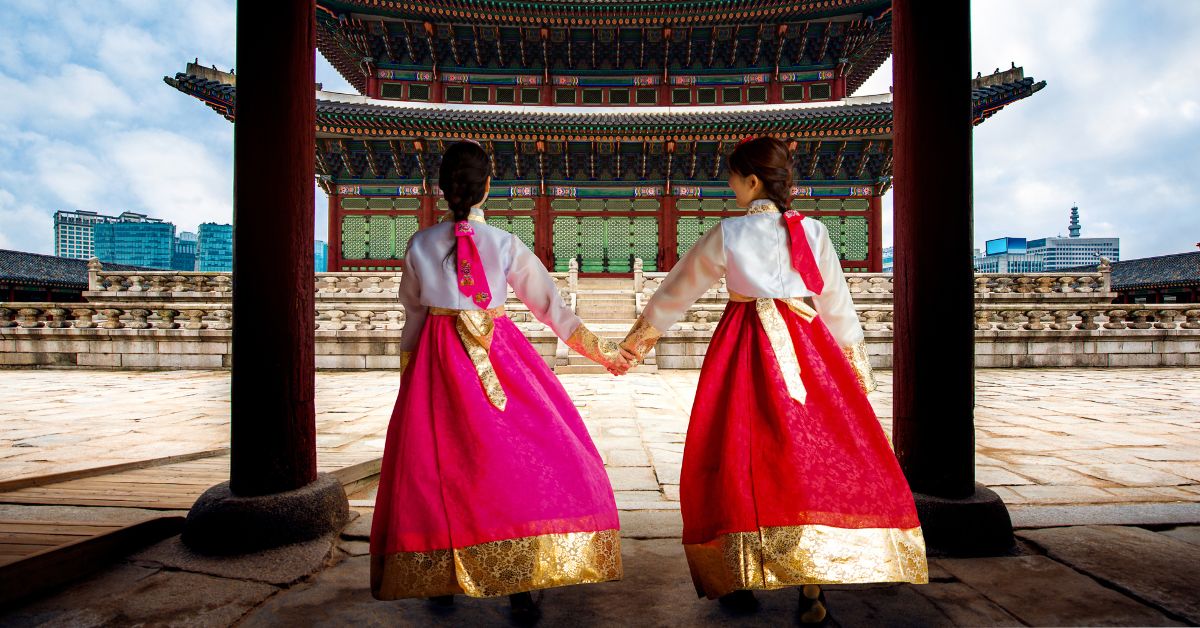
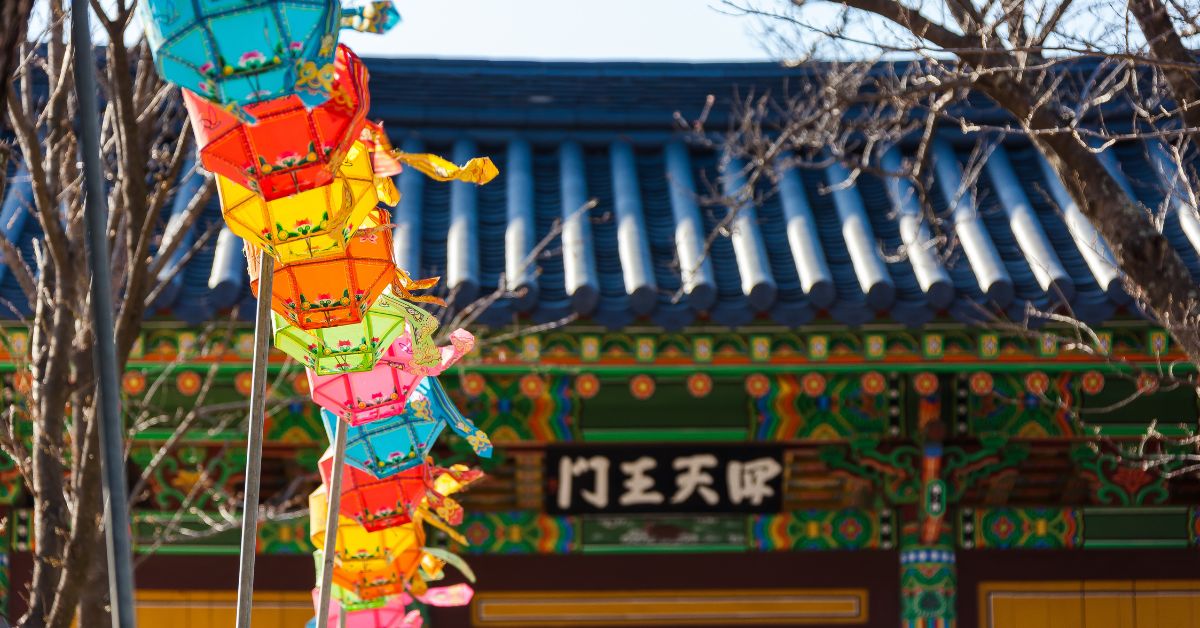
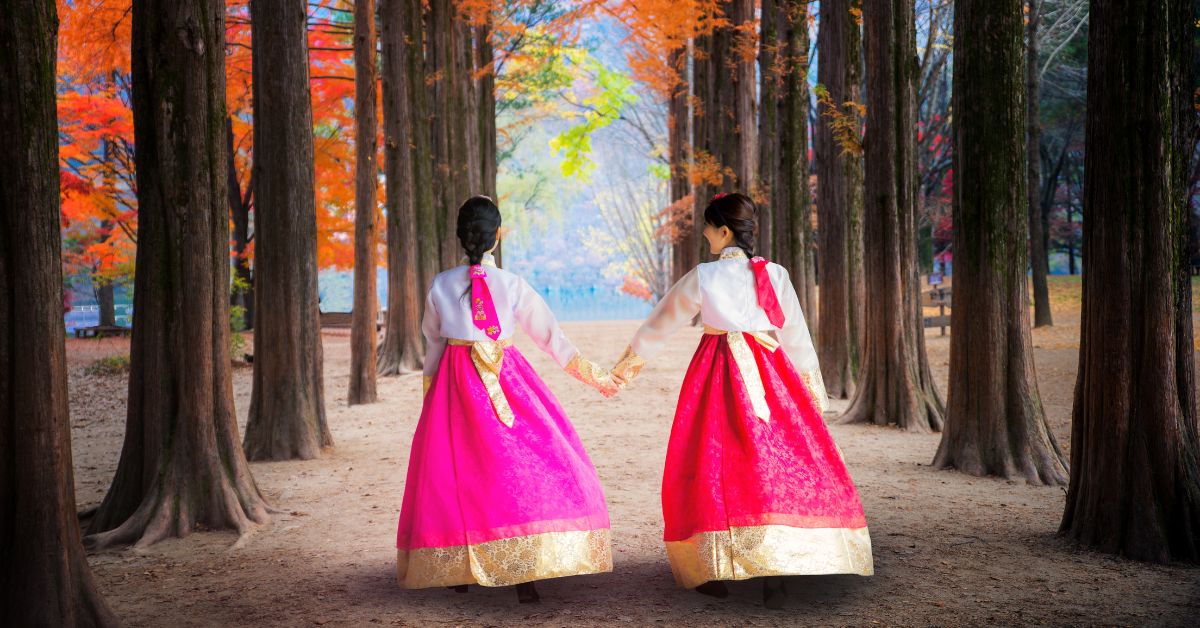

Hi May I know if there is a tour organised for Fall Foliage Spots?
Hi Emily, there are tours available for fall foliage sites across Korea. Are you looking for a one day tour, or a mutli-day guided tour to several locations?
I’m so thankful for everything I have, and Chuseok is a time to keep in mind
that.
halo.. i hv plan go to korea in Nov 19 until 26 Nov 2023. There still can be see Autumn Foliage?
Hi, sorry, but autumn leaves are all gone by then and the winter weather begins. There might be a few leaves left on the ground, but not really much to see.
ah i see.. where the place might be i can see autumn foliage on that date?
There aren’t any places, sorry.
Hi! Are there still fall foliage during Nov 12 to 16 when we visit Korea?
That’s a bit late for fall foliage in most places. There may be some gingko leaves around by then in southern parts of Korea, but most will have dropped off and been blown away by then. Naejangsan National Park is one of the last places to see fall foliage in Korea, so that would be your best option.
Hi , I am going to Seoul and Jeju in 4th Oct week to first week of Nov, should I go to Jeju first then Seoul so that I dont miss the autumn foilage?
Where is the best place to stay to have a nice view of the foilage for both Jeju and Seoul?
Thanks.
Hi, sounds like you’ve got a long time in Korea. If you want to see autumn leaves around Seoul, then maybe it would be best to visit Jeju first (early-October is a lovely time for Jeju). Seoul’s autumn leaves really shine later in the month, so visiting Seoul later would be a good option, yes.
I wouldn’t worry too much about staying in specific places to see the leaves, as you can see them all around and I would recommend choosing somewhere that’s convenient for travelling around to various places. Hongdae and Myeongdong are convenient neighbourhoods in Seoul, as well as Insadong (closer to palaces and autumn views near there). For Jeju, it depends on what you want to do. Jeju City and Seogwipo are convenient bases for visiting most places on Jeju, whereas beaches like Hamdeok Beach or Hyeopjae Beach are great for seaside views and staying on the shore.